The great outdoors: this summer’s most exhilarating installations
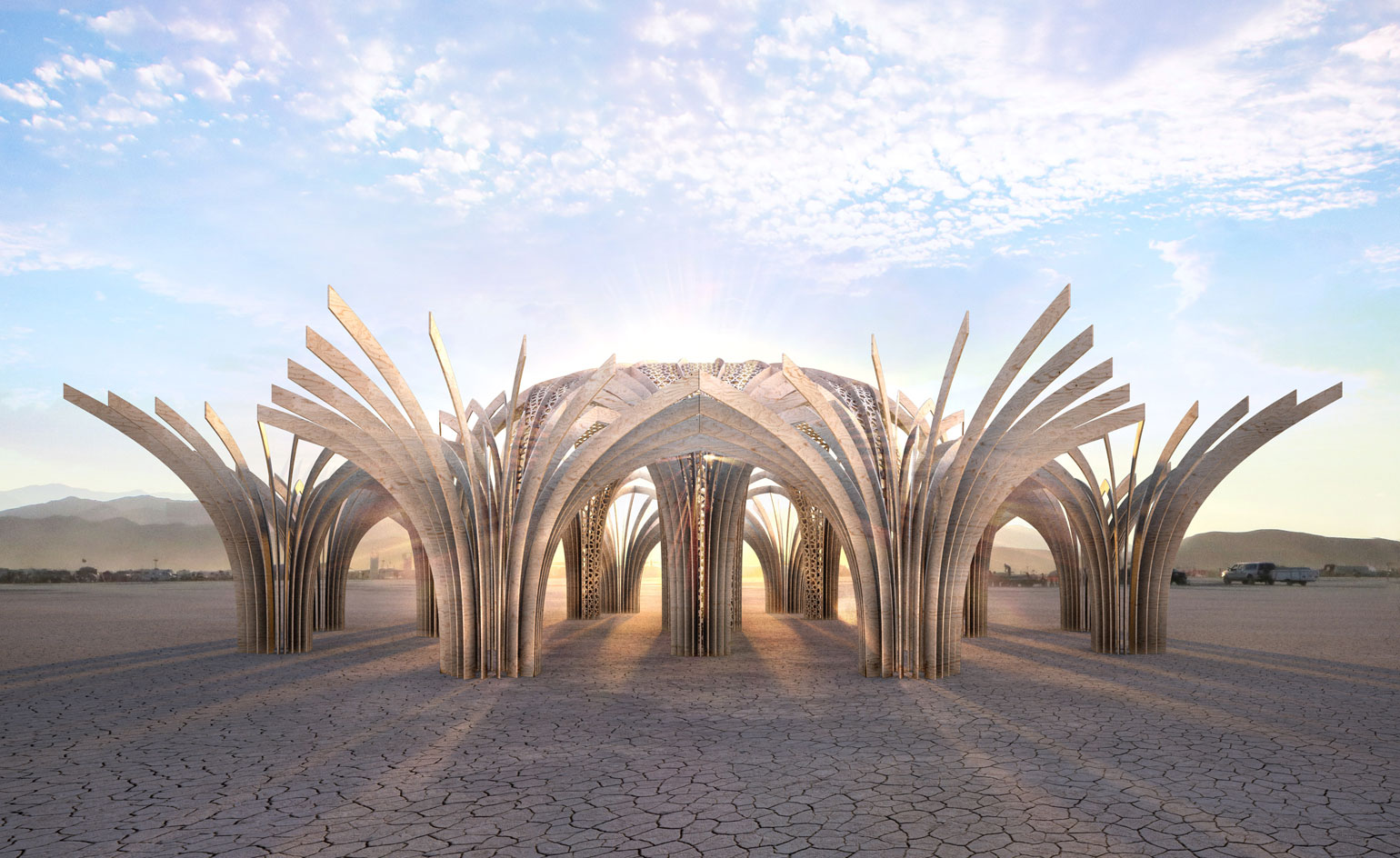
With the weather heating up, we're turning our attention to the artists and designers taking their installations outside for the summer months. The great outdoors is becoming a hotspot for creatives embracing the challenge to go bigger and better with their work, inspiring experimentation with the environment and materials. From a paper bridge in the middle of the Lake District, a mountain of plywood in the dry Nevada desert or gallons of florescent paint on a Manhattan poolside, we explore the most imposing outdoor spectacles on show this season…
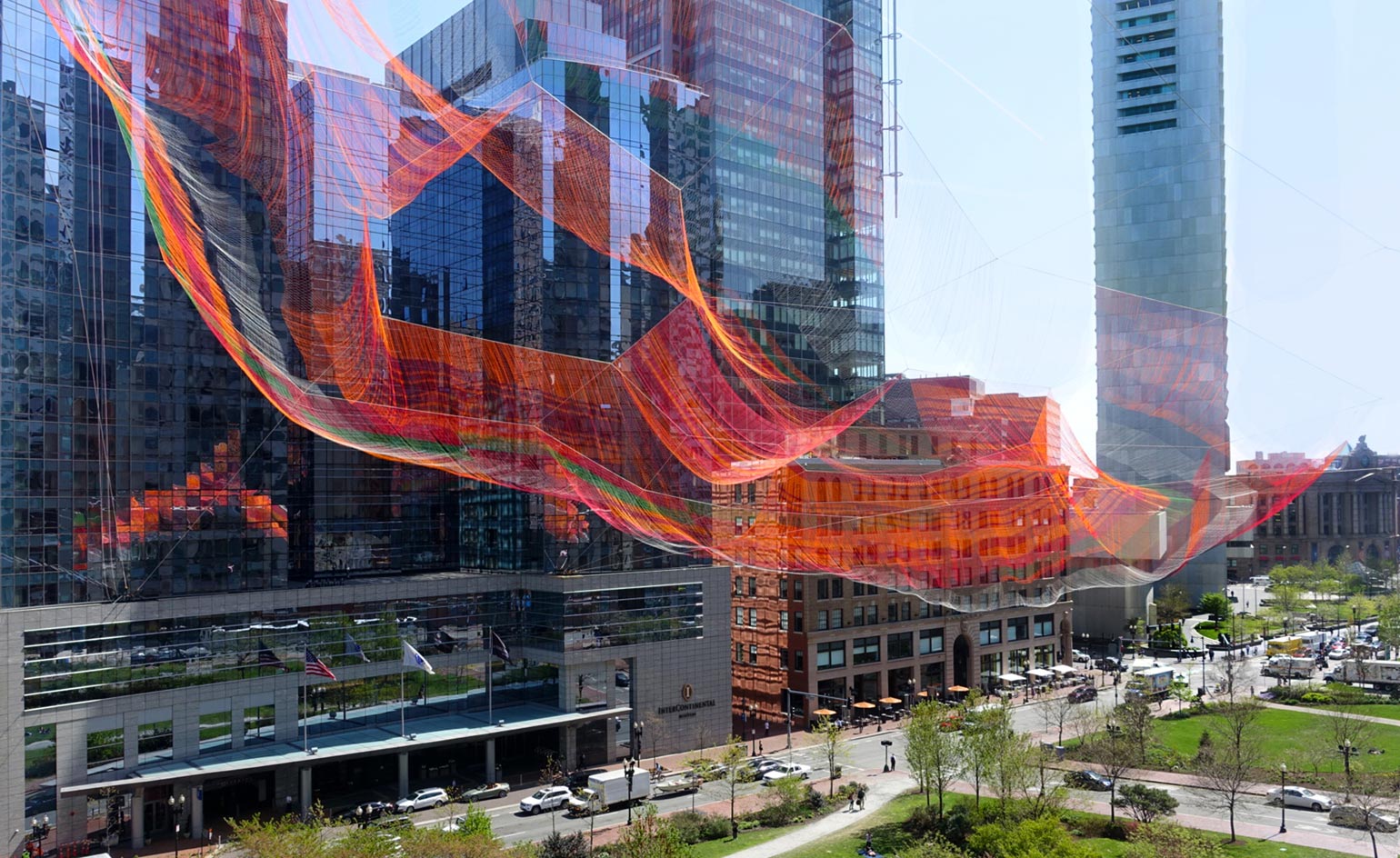
As If It Were Already Here, Boston, USA
Janet Echelman's giant aerial sculpture soars 365 feet in the air above the Fort Point Channel Parks in downtown Boston. Spanning over 100 miles of fibrous rope - a material said to be 15 times stronger than steel and yet incredibly lightweight - the installation is part spider's web, part bubble, part fishing net.
Writer: Sam Rogers.
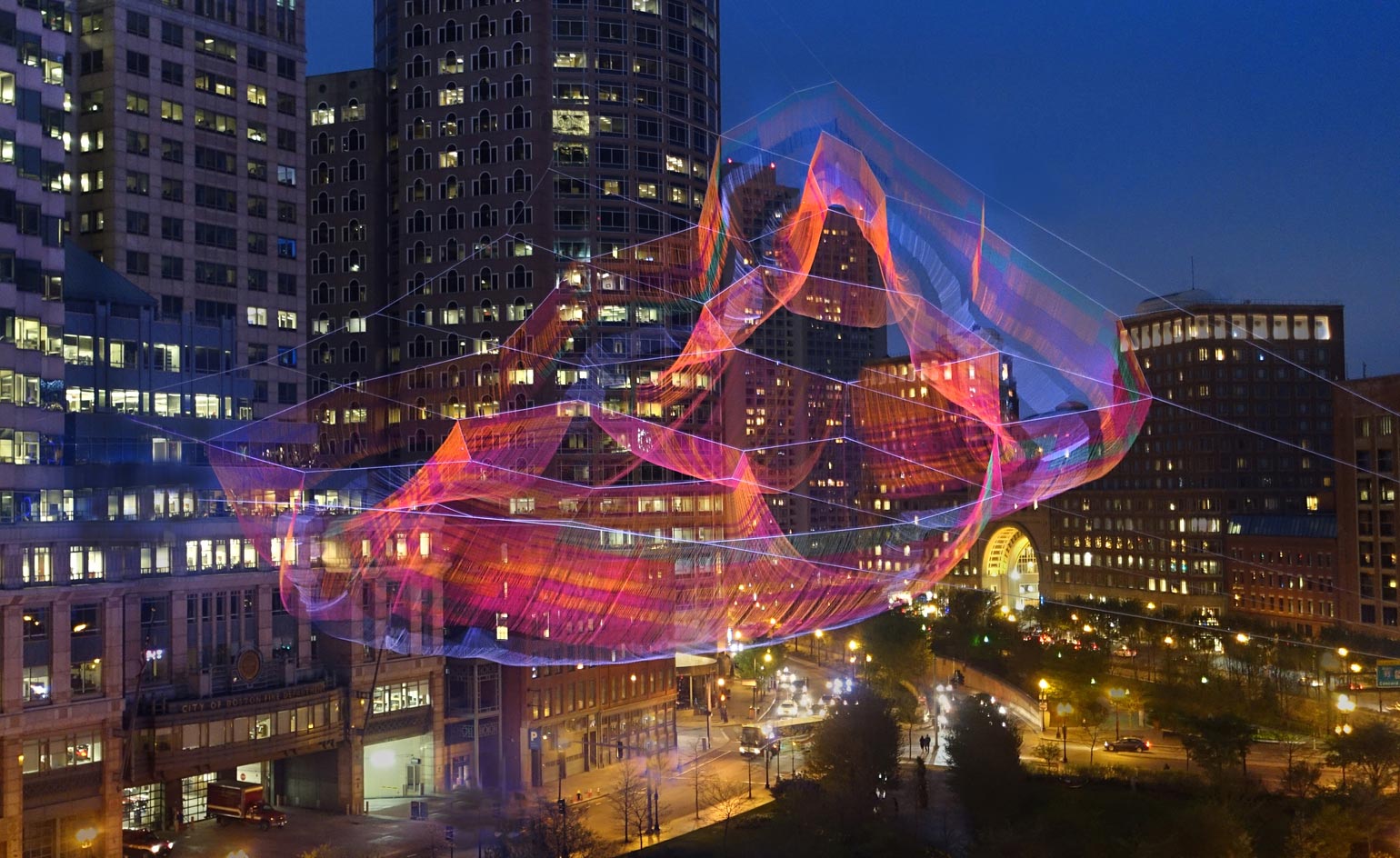
As If It Were Already Here, Boston, USA
The polyester twine and polyethylene ropes - chosen for their elasticity, movement and strength - make it appear at times as though a giant spider has woven a web of sorts between the city's buildings. At other times it looks more like a fisherman's net, anchored downtown. The colourful hues of the swaying threads mean it also resembles a bubble though, vivid with the play of soap and light.
Writer: Sam Rogers.
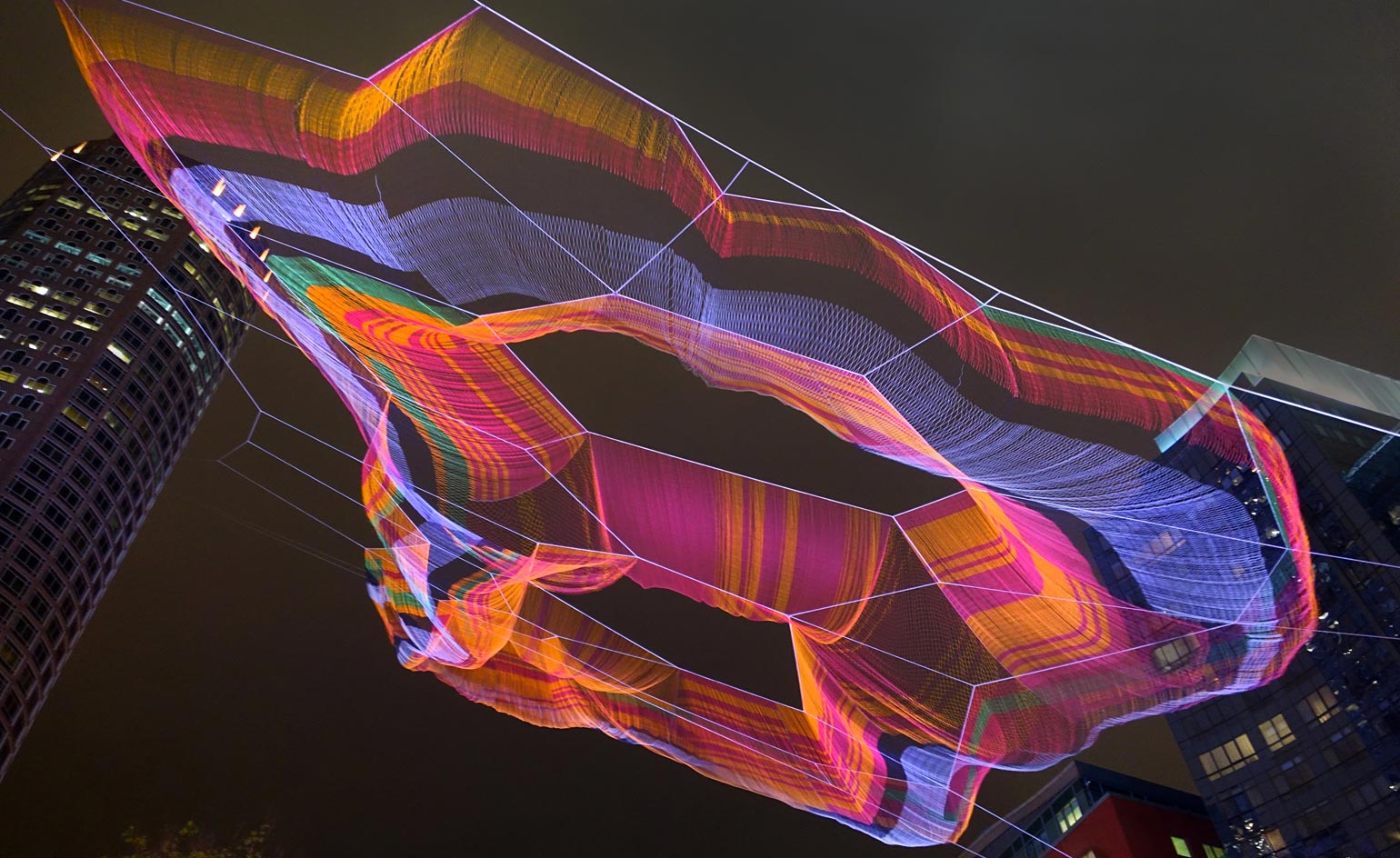
As If It Were Already Here, Boston, USA
The artwork incorporates 'dynamic light elements' which react to the wind; sensors register movement and tension, manifesting data into the colour of light projected onto the sculpture's surface. Echelman is known for her billowing, reactive sculptures and has previously created major installations in Amsterdam, Sydney, Vancouver and Singapore, as well as American cities like Phoenix and Denver. This latest commission will remain in place until October 2015 and forms part of the Greenway Conservancy's public art programme.
Writer: Sam Rogers.
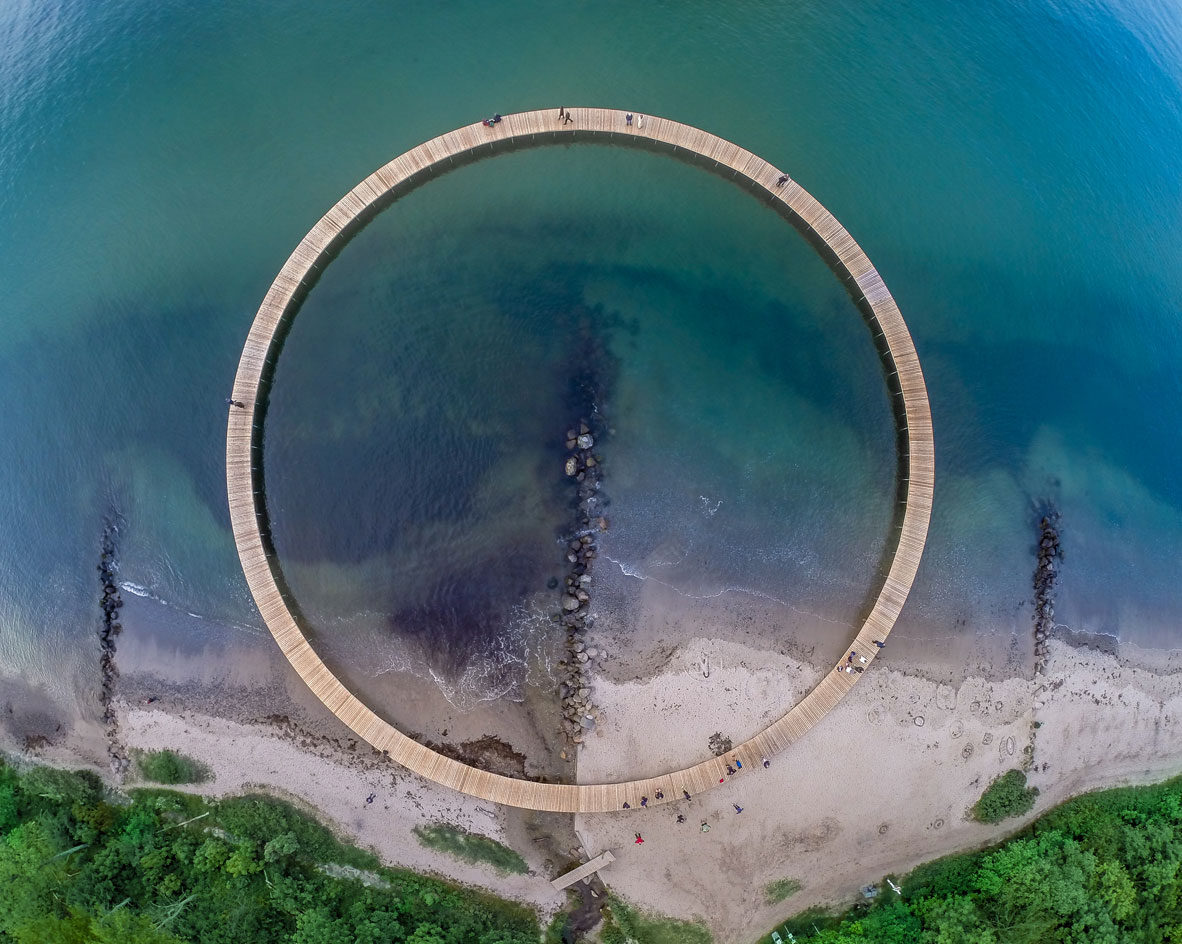
The Infinite Bridge for Sculpture by the Sea, Aarhus, Denmark
Those craving a coastal adventure will want to visit Denmark’s international biennale, Sculpture by the Sea near Aarhus. It is here that the Danish practice of Gjøde & Povlsgaard Arkitekter have created their ‘Infinite Bridge’, an impressive ring-like structure that spans 60 meters in diameter; half at sea and half on land. Although arguably best seen from above – deftly captured by Aarhus Billeder here – the concept of infinity is intelligible from the ground.
Writer: Sam Rogers.
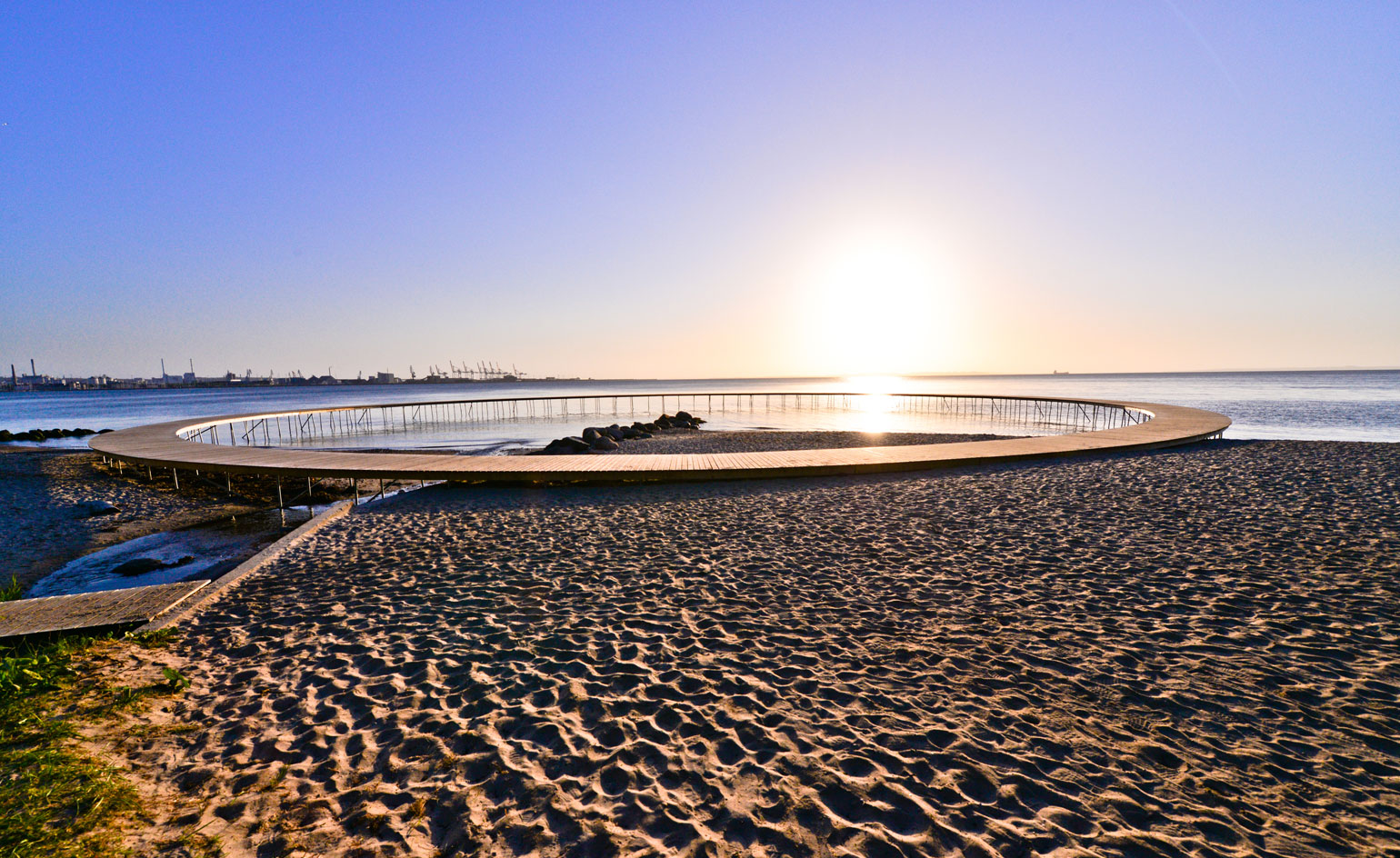
The Infinite Bridge for Sculpture by the Sea, Aarhus, Denmark
The structural sculpture is ‘all about experiencing the surroundings and becoming aware of the relation between the city and the magnificent landscape of the bay,’ explains Johan Gjøde, partner and co-founder of Gjøde & Povlsgaard Arkitekter. ‘Walking on the bridge you experience the changing landscape as an endless panoramic composition. At the same time you enter a space of social interaction with other people experiencing the same panorama.’
Writer: Sam Rogers
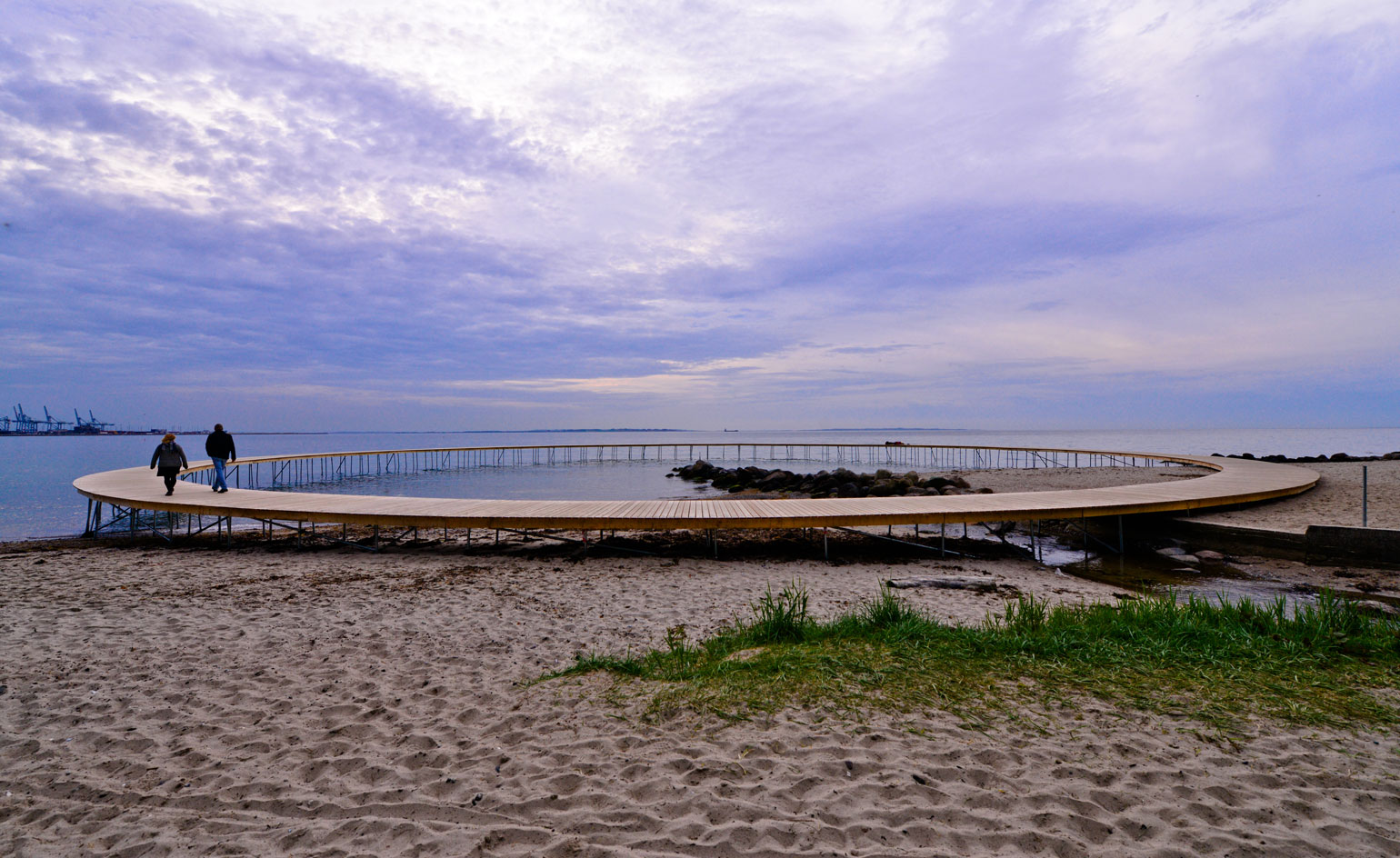
The Infinite Bridge for Sculpture by the Sea, Aarhus, Denmark
60 identical wooden elements placed on steel pillars make up the deck, which – depending on the tide – rises one or two meters above the water’s surface. The curvature of the bridge mimics the contours of the landscape and touches on the landing dock a previous pier, long since demolished.
Writer: Sam Rogers
Receive our daily digest of inspiration, escapism and design stories from around the world direct to your inbox.
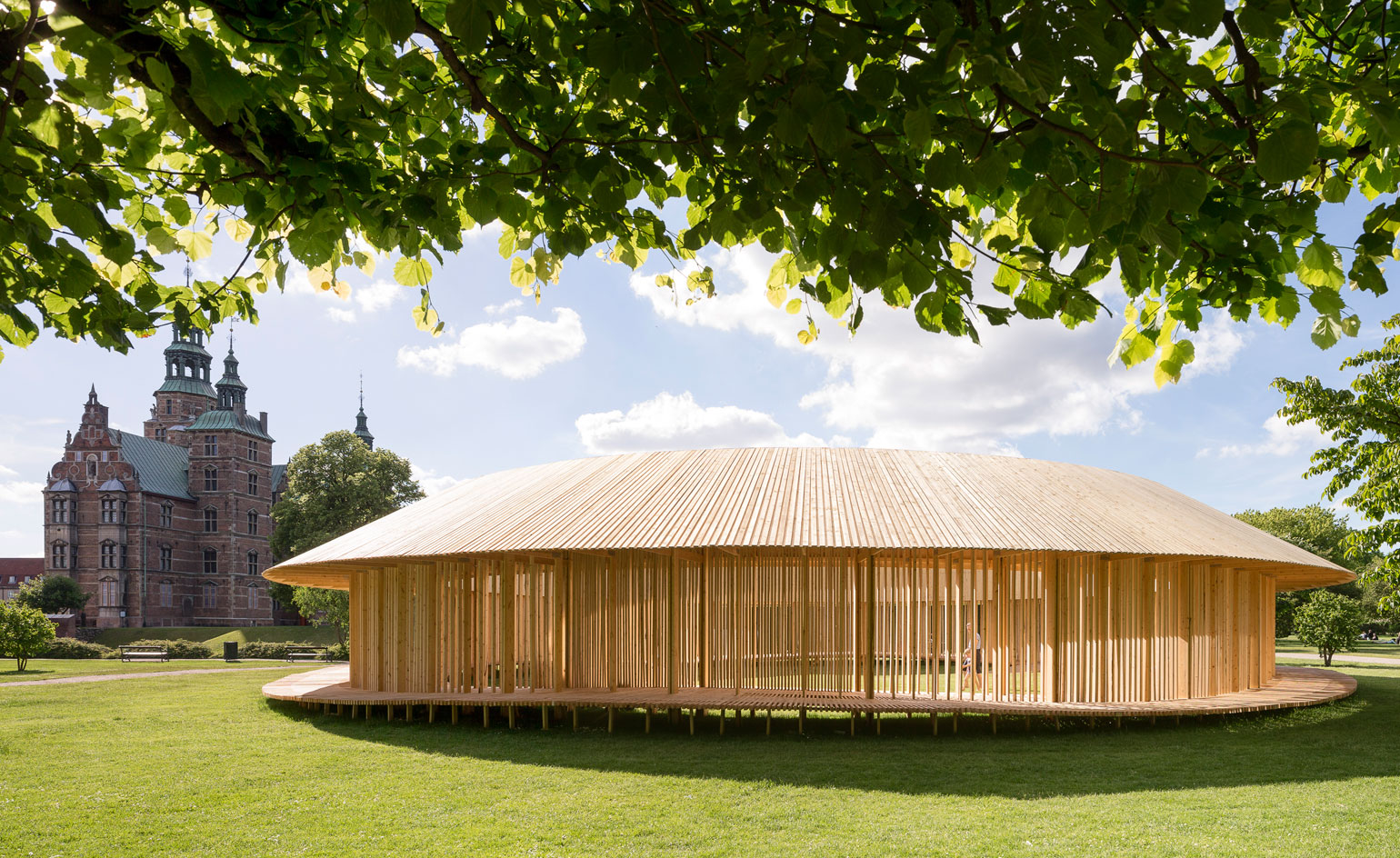
Around Pavilion, Rosenborg Castle, Copenhagen, Denmark
Sitting in the shadow of the castle it was inspired by, the Around Pavilion is a ring-shaped wooden structure created by Mikkel Kjærgård Christiansen and Jesper Kort Andersen. Throughout summer, the pavilion will play host to a range of activities, from food festivals to music concerts, theatre performances and story-telling events.
Writer: Sam Rogers.
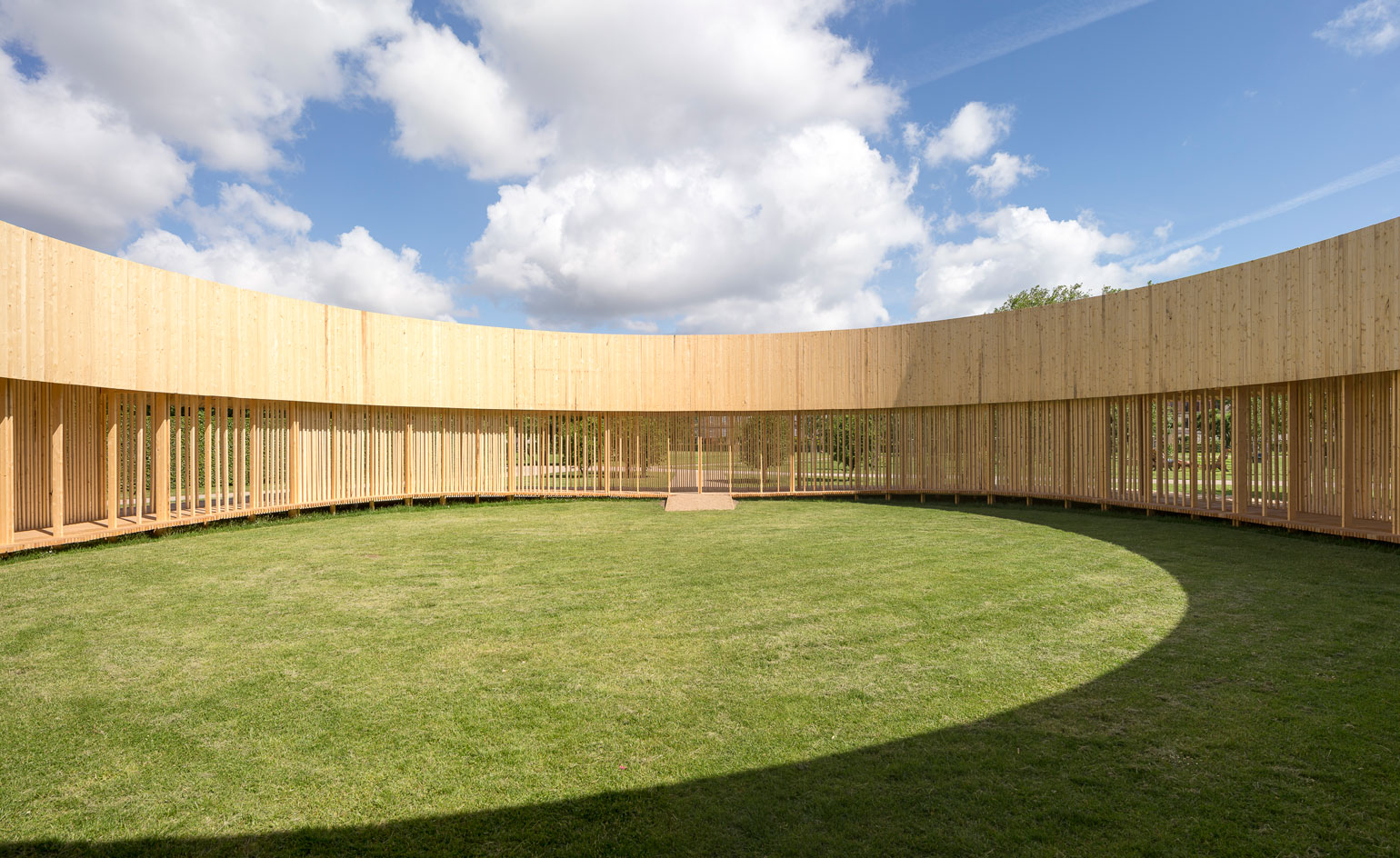
Around Pavilion, Rosenborg Castle, Copenhagen, Denmark
Built by local carpenter apprentices using batons of Nordic pine, the structure feels very much at home in gardens of the 17th-century castle; its round layout pays playful homage to the meticulous geometric layout of the surrounding lawns, hedges and flowerbeds.
Writer: Sam Rogers.
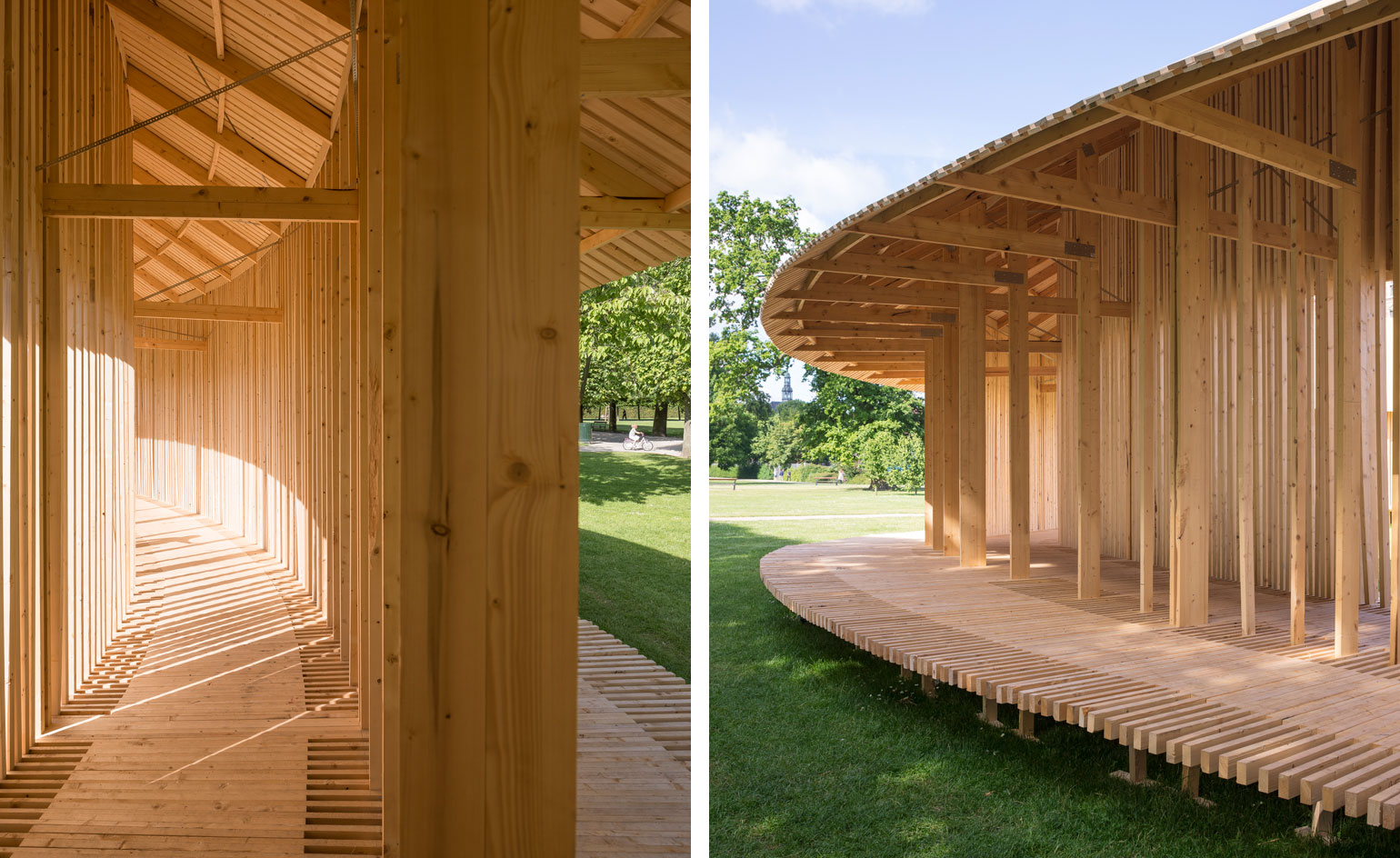
Around Pavilion, Rosenborg Castle, Copenhagen, Denmark
Within, decked walkways wind around the outer edge of the structure, a sloping roof providing temporary shelter. The walkways gently rise and fall, dipping at four points to represent ‘the corners of the world’. The central courtyard is a secluded – yet entirely open – patch of grass where park guests (not royalty) rule, making it a true urban oasis.
Writer: Sam Rogers.
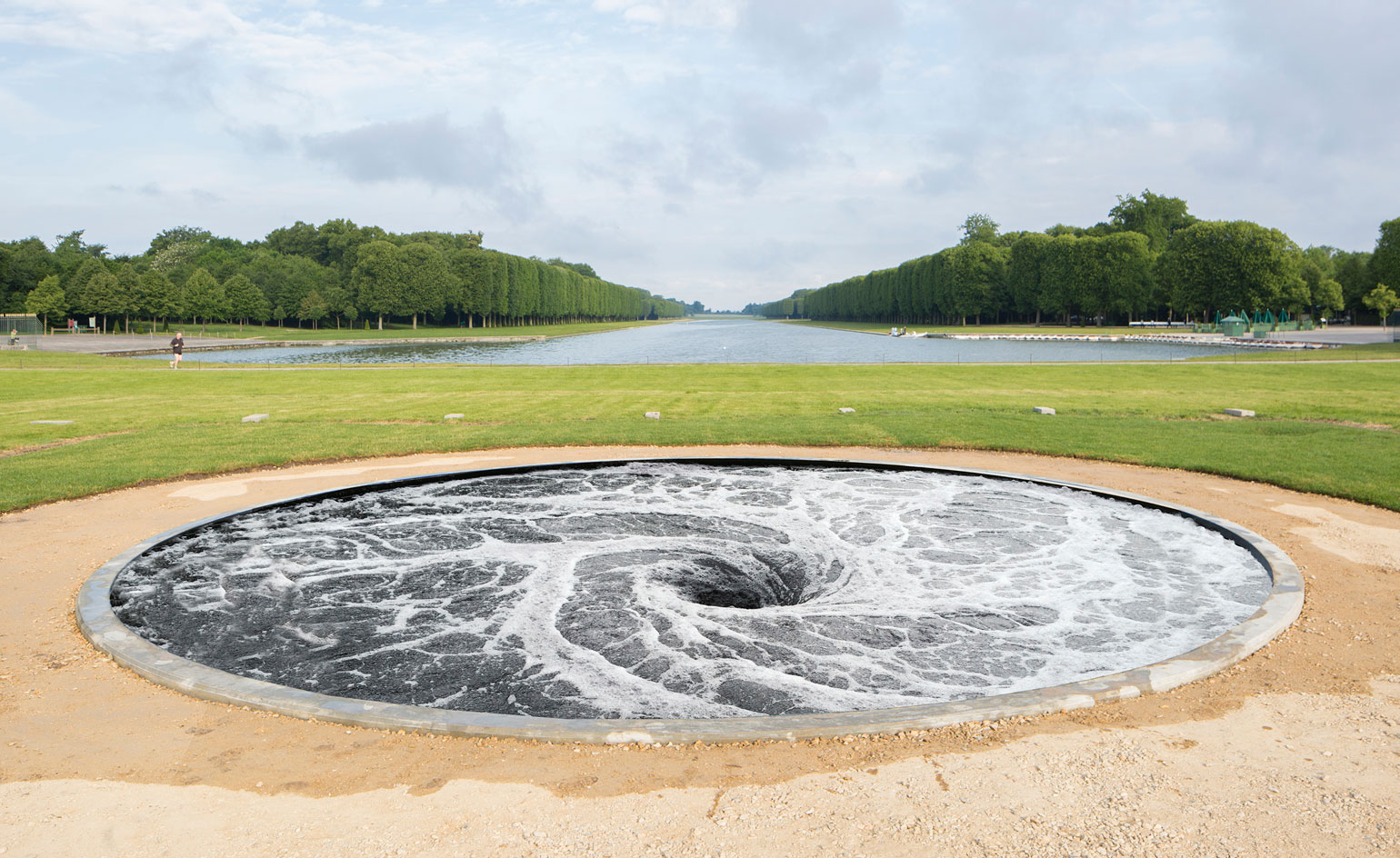
Anish Kapoor, Palace of Versailles, France
The British sculptor continues his exploration of the sublime by inviting outright controversy and hedonism into the Palace of Versailles's expansive grounds. Six works are dotted around the Chateau's manicured gardens and nearby Salle du Jeu de Paume. Pictured: Descension, 2014.
Writer: Rooksana Hossenally.
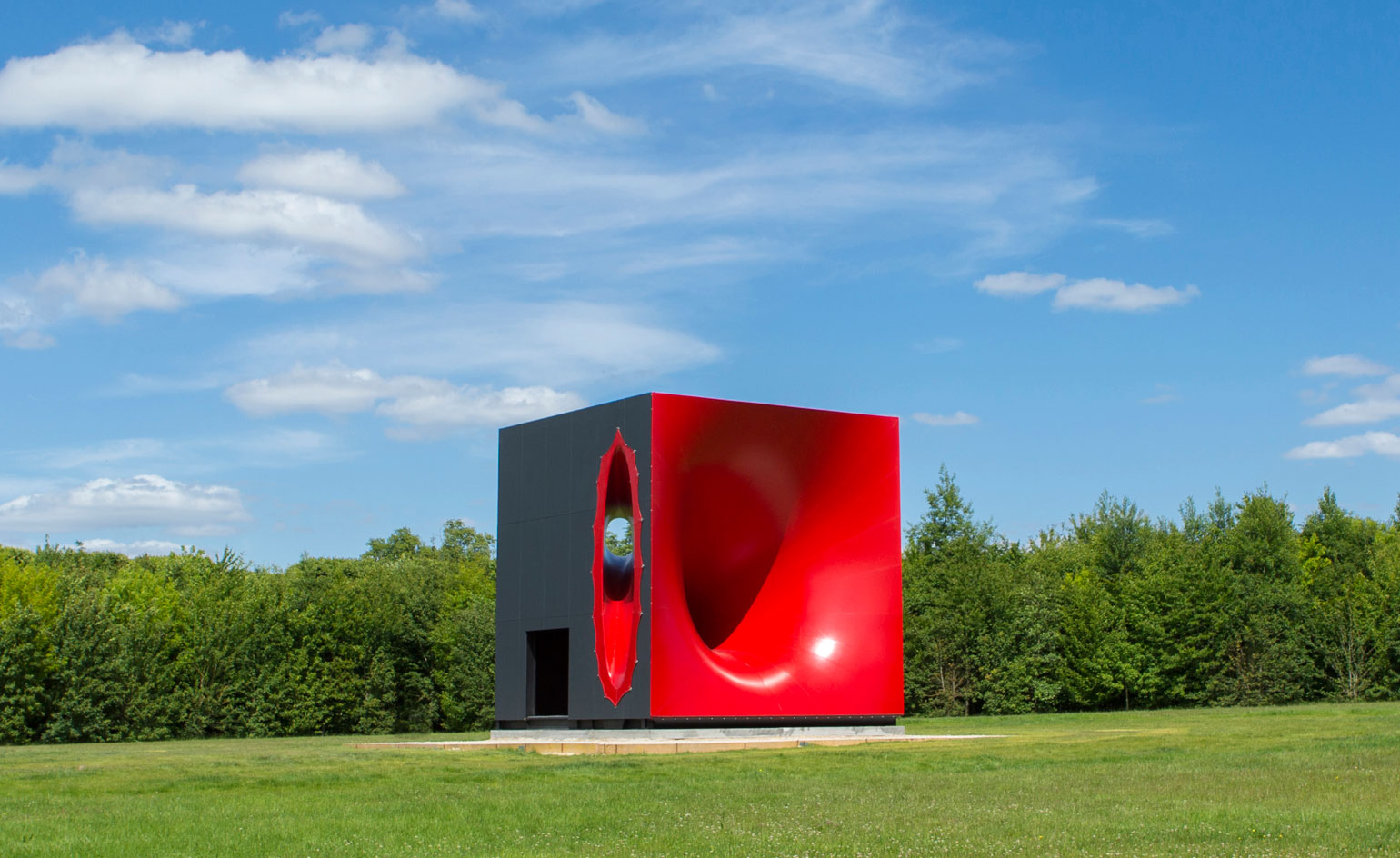
Anish Kapoor, Palace of Versailles, France
Kapoor's pieces comprise themes of light, darkness and decision. 'I hope the narrative makes viewers feel uncomfortable at times,' the artist explains. 'I'm not interested in commentary though – I'm not trying to say what things mean.' Pictured: Sectional Body preparing for Monadic Singularity, 2015.
Writer: Rooksana Hossenally.
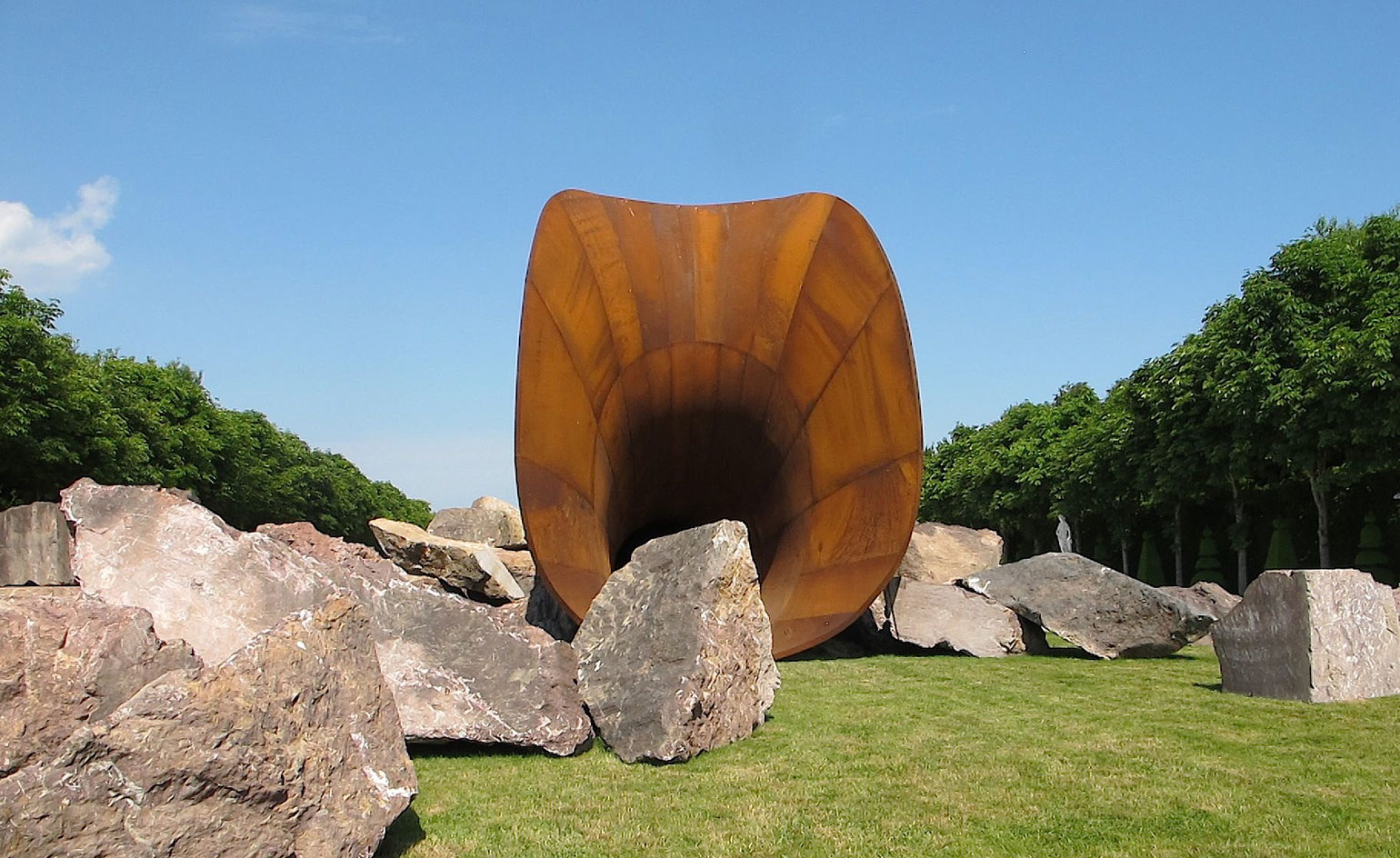
Anish Kapoor, Palace of Versailles, France
Kapoor caused nationwide controversy with Dirty Corner, pictured. Flippantly defined as 'the queen's vagina' – a link the artist has since dismissed – Kapoor believes focusing on sexuality in the work is a 'non-subject' that cuts the rest of the dialogue short.
Writer: Rooksana Hossenally.
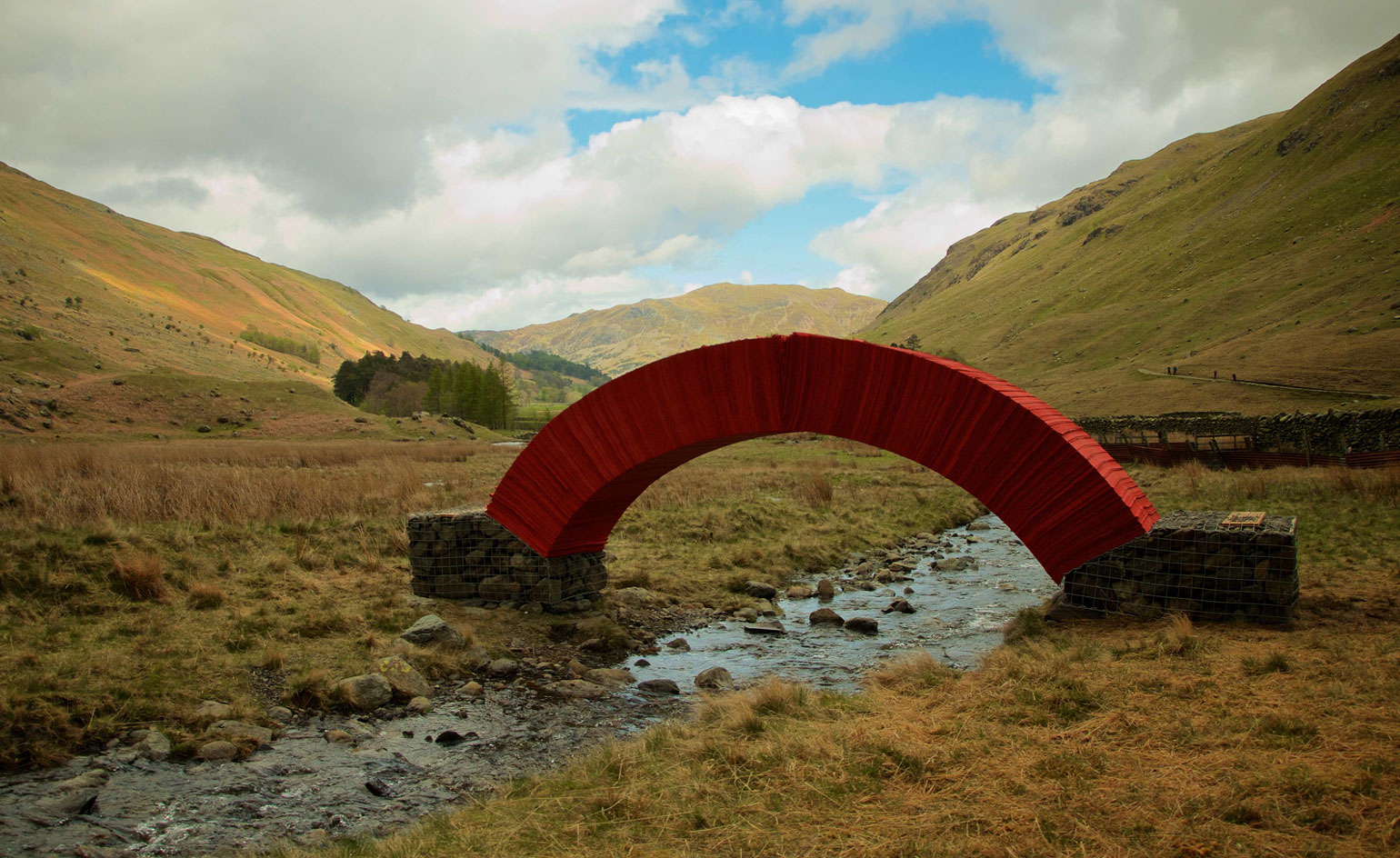
PaperBridge, Grisedale Valley, UK
Steve Messam's site-specific project realised a motivation to work outdoors, creating an environmental art connected to agricultural practice. In PaperBridge, the artist presented a meticulously built paper construction, in surreal contrast with the wild environment it sat in. The ephemeral installation was accessible by foot only and was on view for ten days.
Writer: Clara Krzentowski.

PaperBridge, Grisedale Valley, UK
The bridge's bright colour exacerbated its peculiar presence, while its shape echoed the undulations of the mountains in the background. The installation blended into the environment while simultaneously maintaining an otherwordly status: it was both in and out of context.
Writer: Clara Krzentowski.
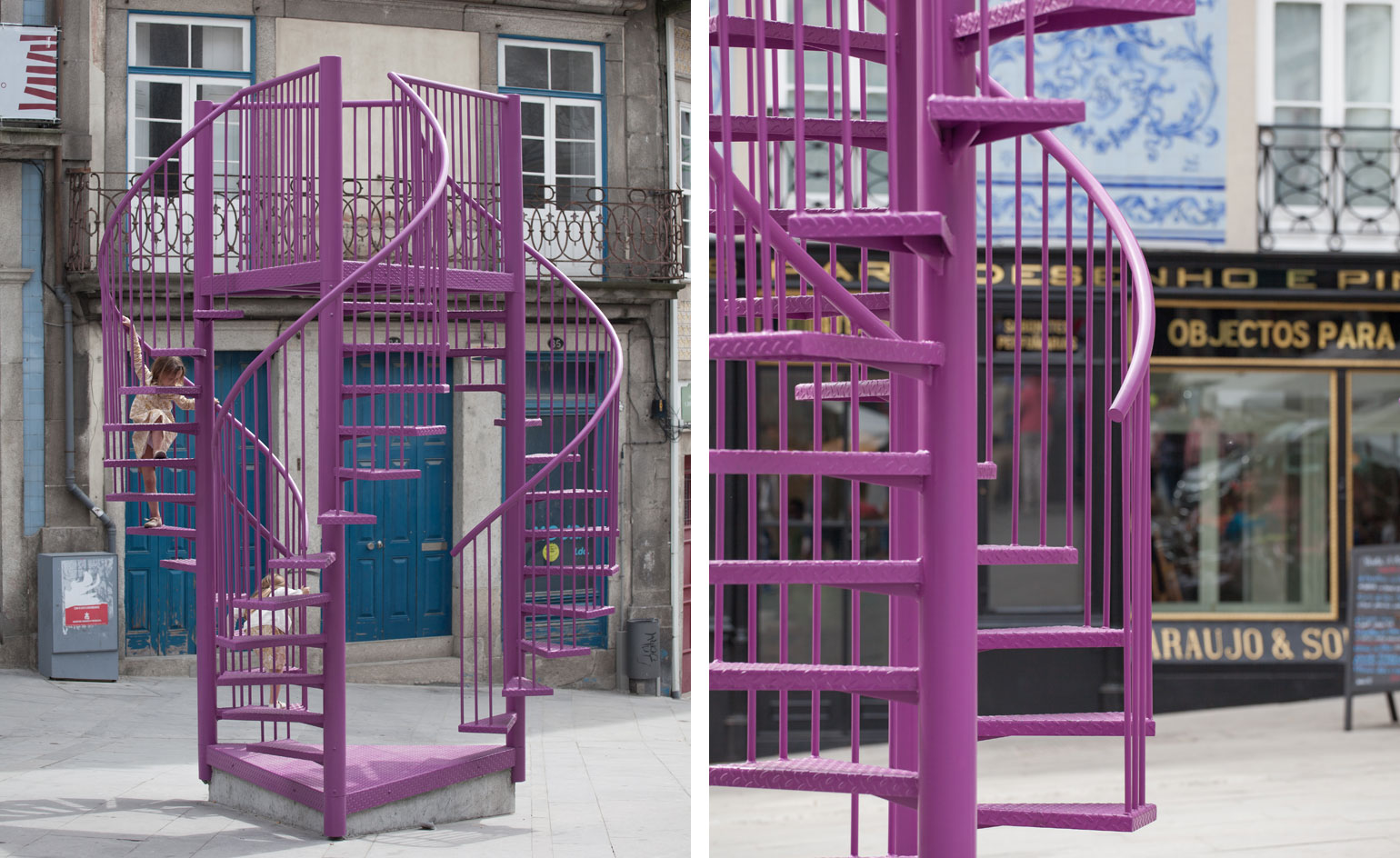
Tripod, Porto, Portugal
Devised by LIKEarchitects, the Escher-like Tripod takes a familiar object – the staircase – and places it in an inconsistent, unfamiliar environment. Three separate staircases are built from six steel portions, joined to a concrete base and spiralling up to a balcony at the top.
Writer: Clara Krzentowski.
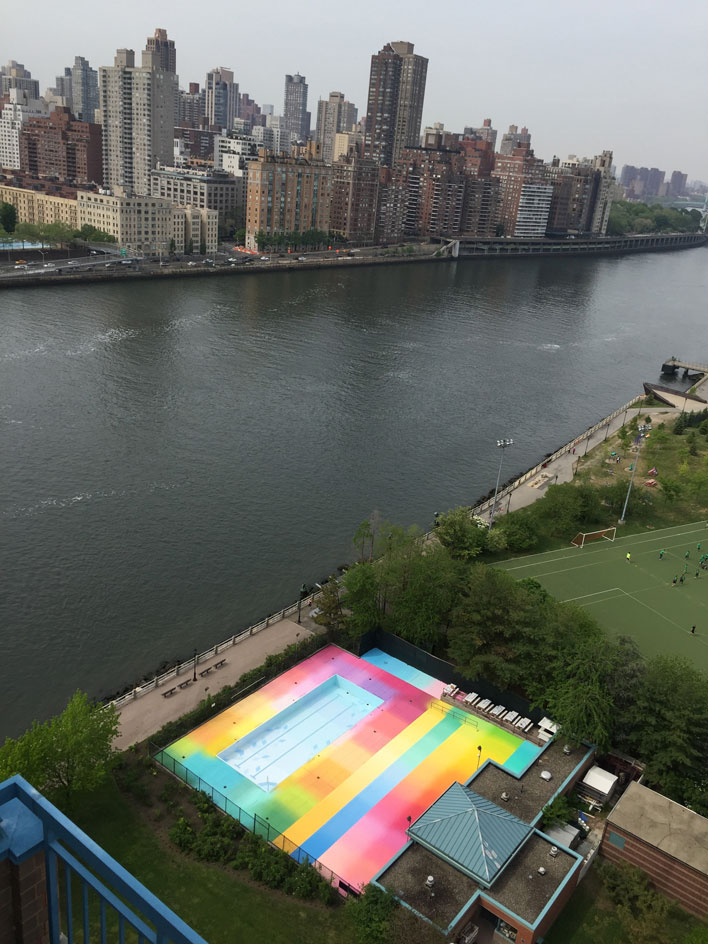
Asylum, Manhattan Park, New York
On show throughout the sunny season, this installation brings a splash of lurid colour to the cosmopolitan shade of New York's Manhattan Park. Designed by street artist Hot Tea, the artwork mirrors his colourful style, with gradient fluorescent tones painted on the decking.
Writer: Sujata Burman.
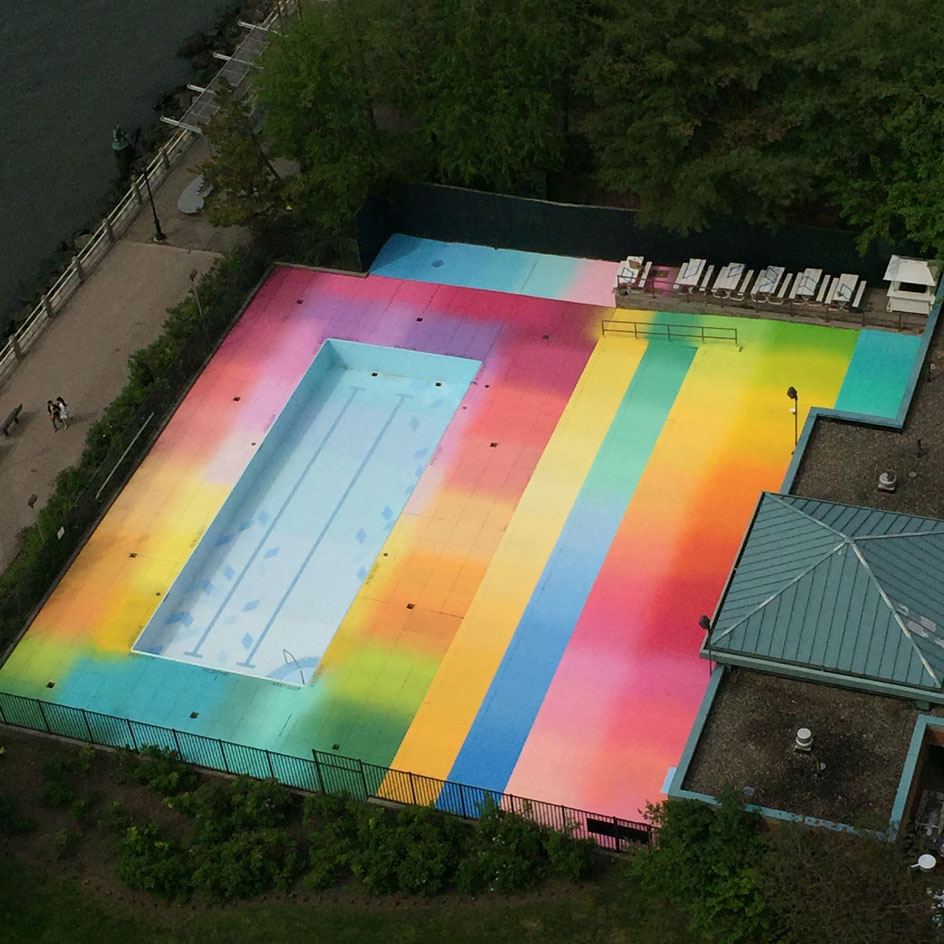
Asylum, Manhattan Park, New York
The work's curators – K&Co design studio and Pliskin Architecture – invited the artist to energise the outdoor pool at Manhattan Park, which he duly did on a scale only truly appreciated via this lofty birds-eye aspect. Asylum's temporary install coincided with a pop-up pool party where people could enjoy the artwork whilst taking a dip.
Writer: Sujata Burman.
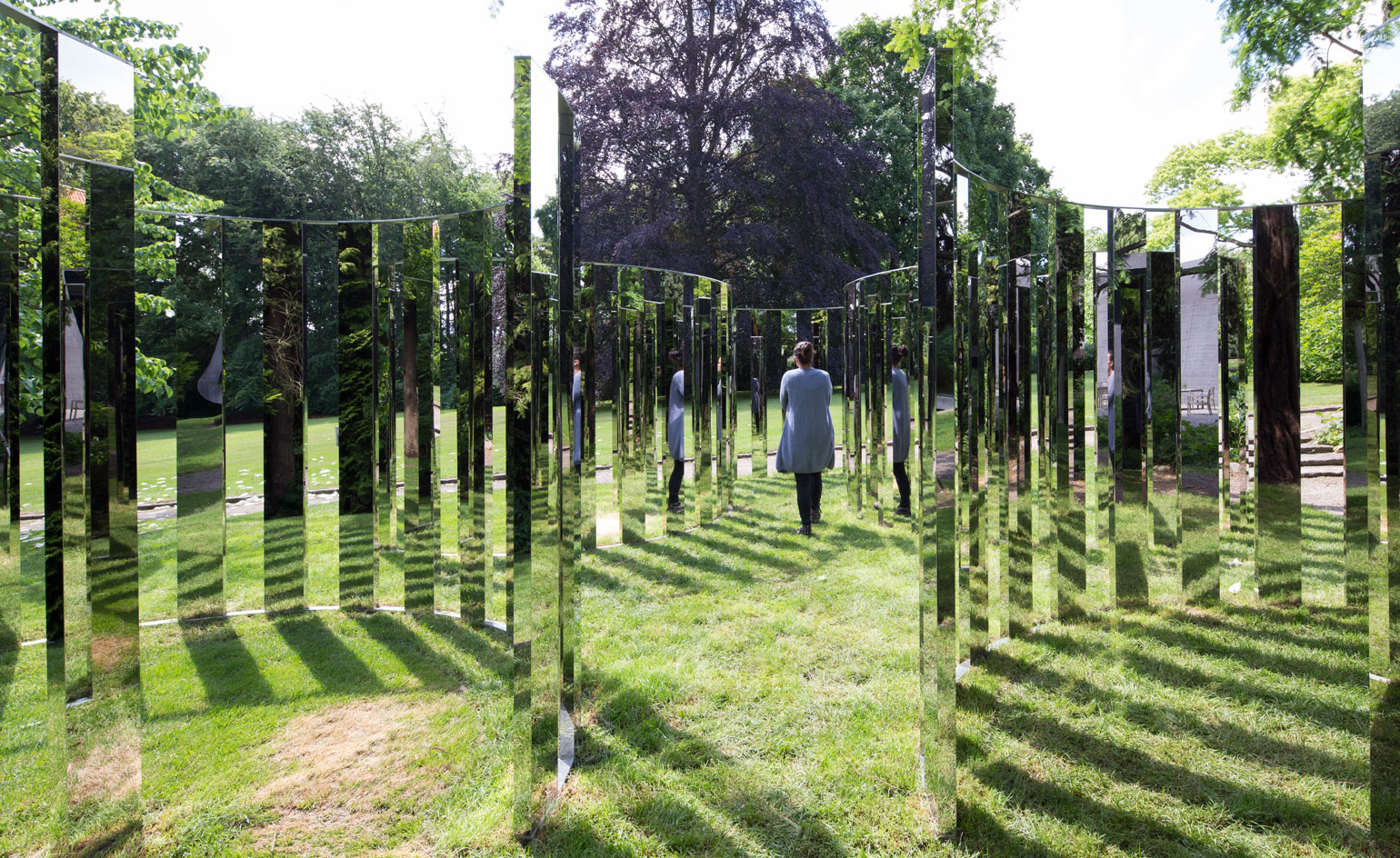
Semicircular Mirror Labyrinth II, Ordrupgaard, Denmark
Installed in the grounds of Denmark's Ordrupgaard museum, to the north of Copenhagen, Jeppe Hein's installation creates a kaleidoscopic effect in its use of mirrored walls. The result is a disorientating work of myriad images and seemingly impossible angles from which to view them.
Writer: Clara Krzentowski. Photography courtesy of König Galerie, Berlin, 303 Gallery, New York and Galleri Nicolai Wallner, Copenhagen
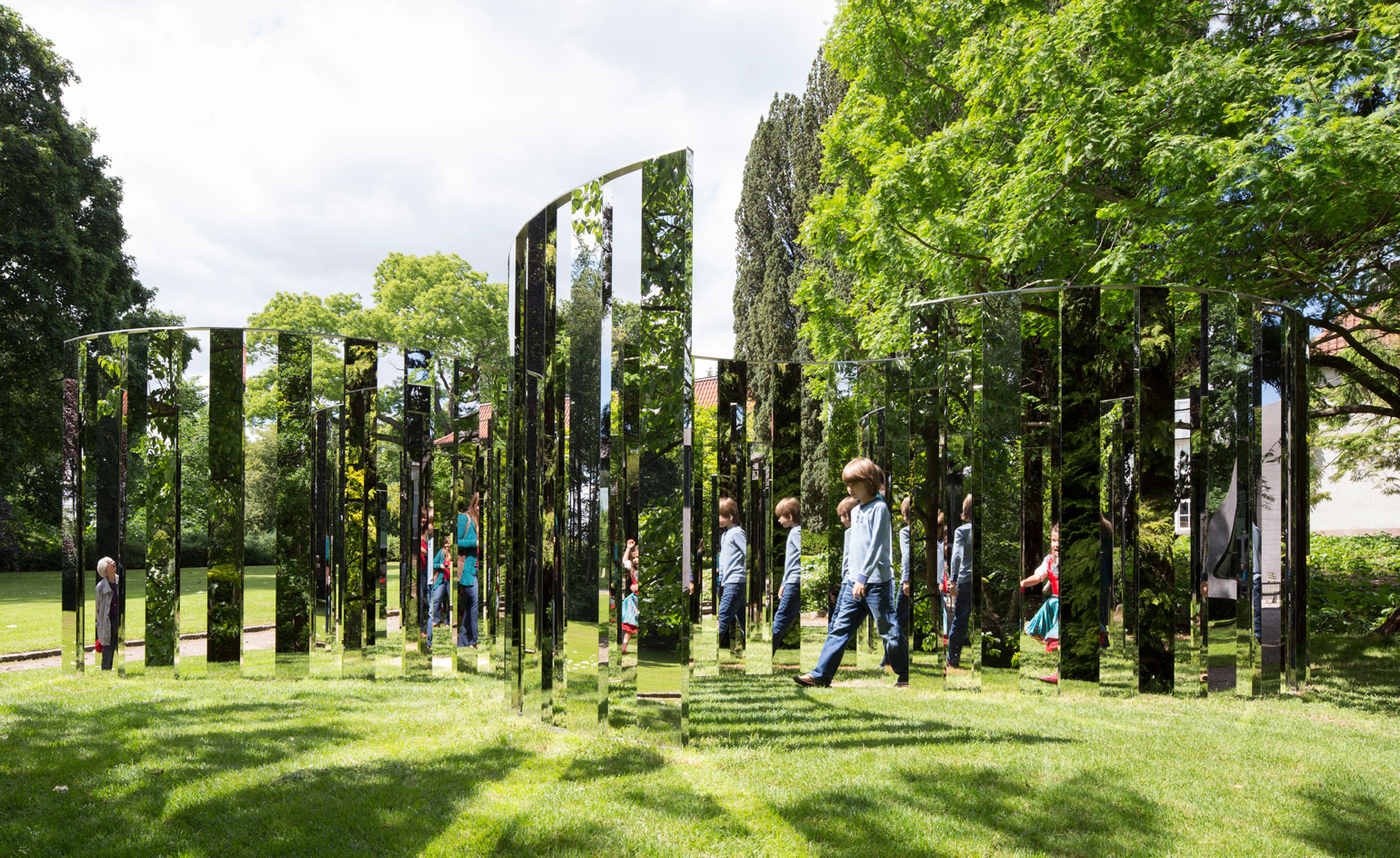
Semicircular Mirror Labyrinth II, Ordrupgaard, Denmark
The tall mirrors, intertwining and taking unexpected turns, form a labyrinth of sorts, playfully manipulating the viewer's sensory faculties and confusing perceptions of physical space. The garden enviornment housing the installation is thus distorted and multiplied to infinity.
Writer: Clara Krzentowski. Photography courtesy of König Galerie, Berlin, 303 Gallery, New York and Galleri Nicolai Wallner, Copenhagen
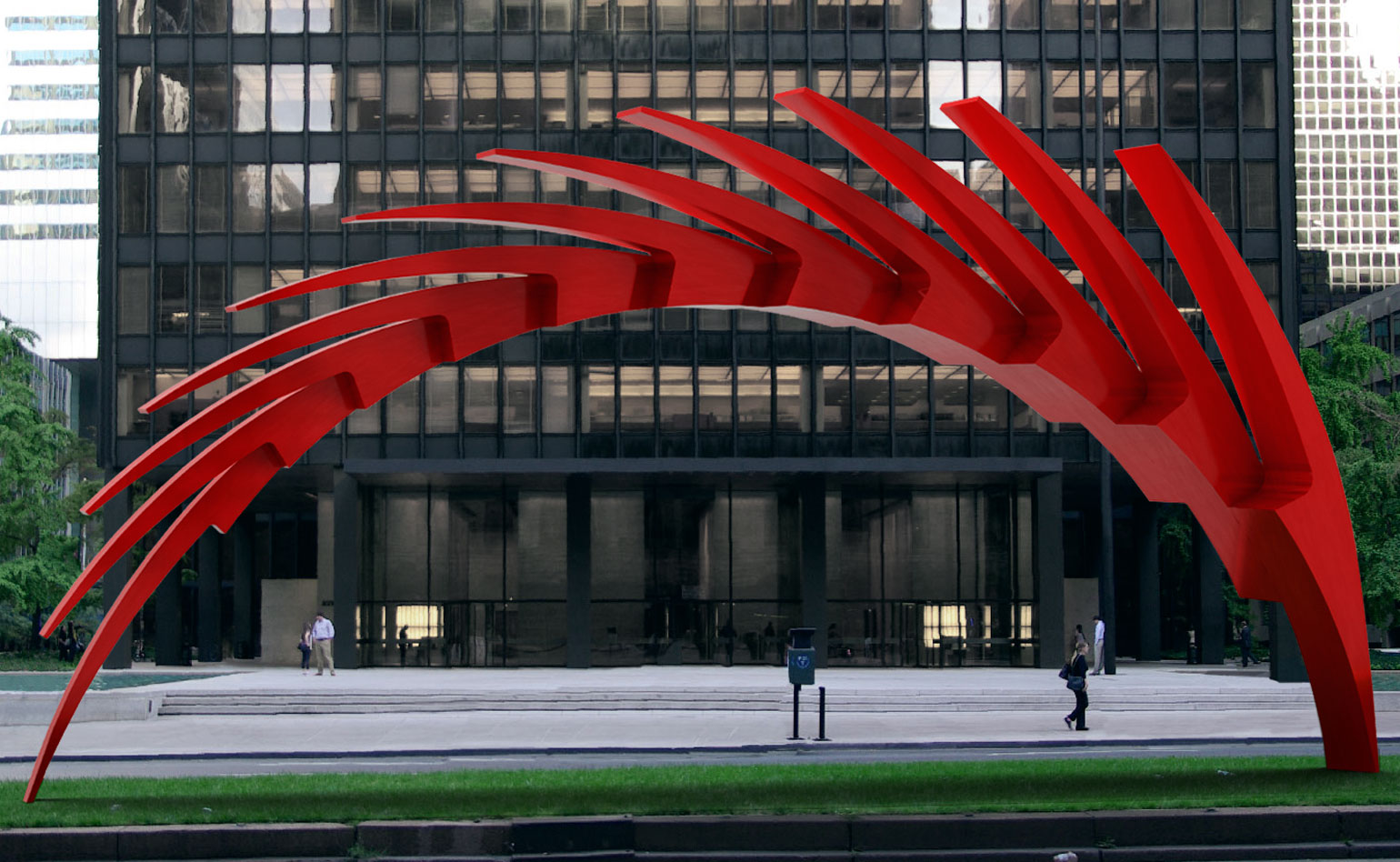
S1, Park Avenue, New York
This aluminium installation is part of a series of seven structures running along Park Avenue in NYC. The exhibition, appropriately named 'On Park Avenue', is the work of Spanish architect and structural engineer Santiago Calatrava. The curvaceous sculpture arches 40ft into the air and its pieces are welded together to form a multi-layer pattern.
Writer: Sujata Burman.
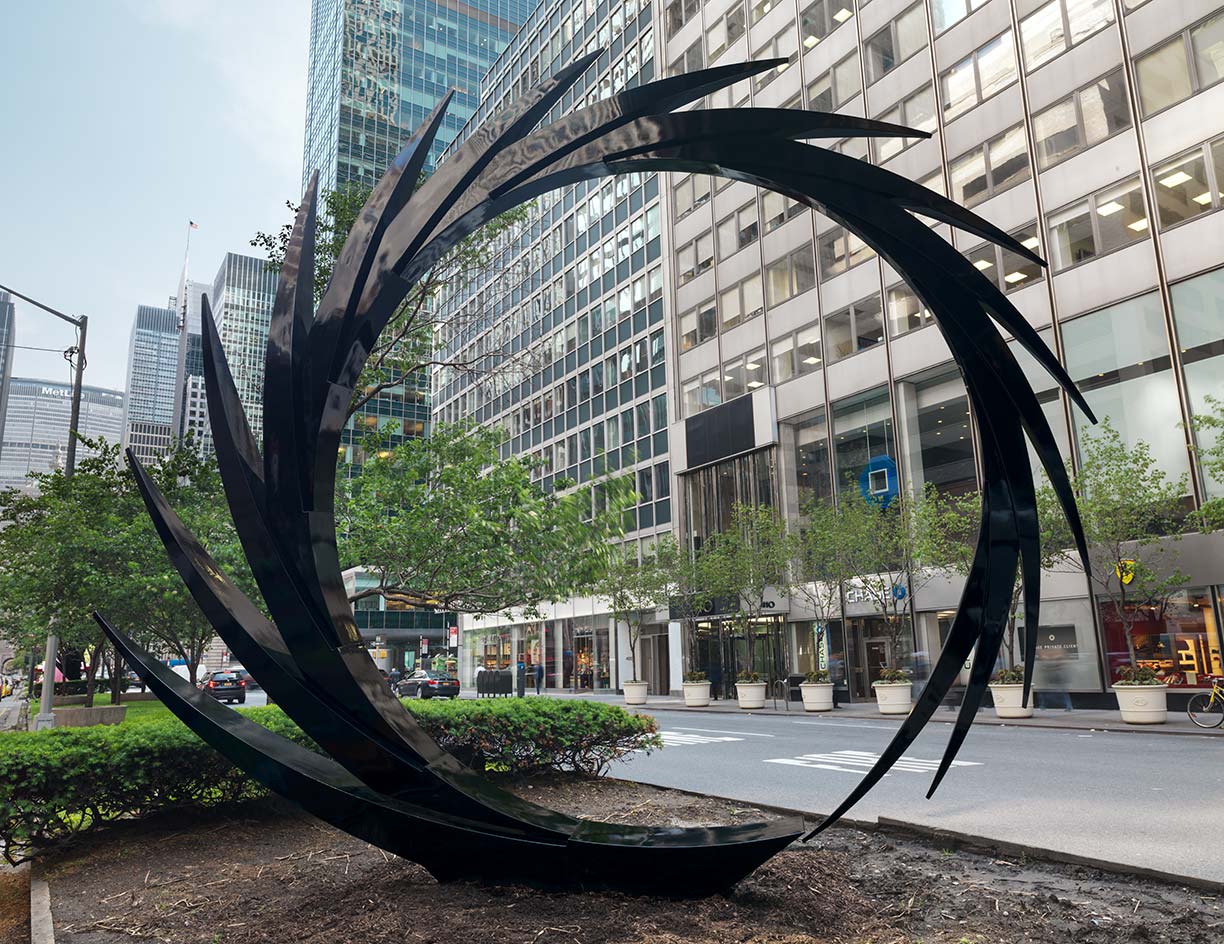
S7, Park Avenue, New York
Patent black and silver versions of the abstract form are included in the collection. The project is co-curated by the Marlborough Gallery, NYC Parks and the Fund for Park Avenue, and will remain in place until November.
Writer: Sujata Burman.

The Arbour, Black Rock Desert, US
The Arbour is designer Josh Haywood's second installation for the Burning Man festival in Nevada's Black Rock Desert. The raw plywood structure channels the vaulting so ubiquitous to medieval architecture, creating ribbed archways for people to walk through.
Writer: Sujata Burman.
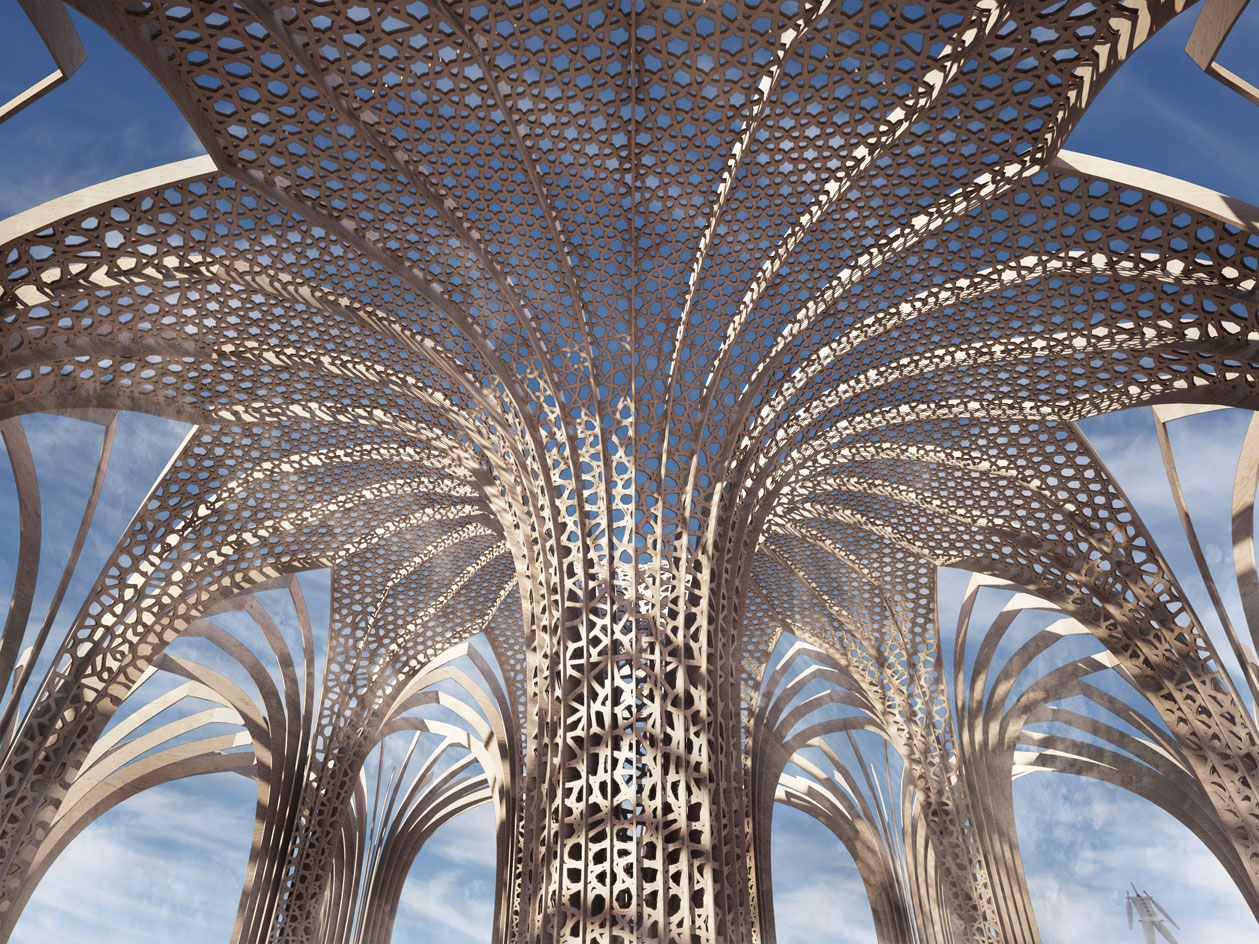
The Arbour, Black Rock Desert, US
Referring to the piece as a 'cathedral of the desert', Haywood draws inspiration from the curved forms of traditional sacred architecture – especially in the laser patterned screens erupting from the ceiling. Crucially, The Arbour will only be built at the festival in August if it reaches a Kickstarter target of £5,000 by 16 July.
Writer: Sujata Burman.
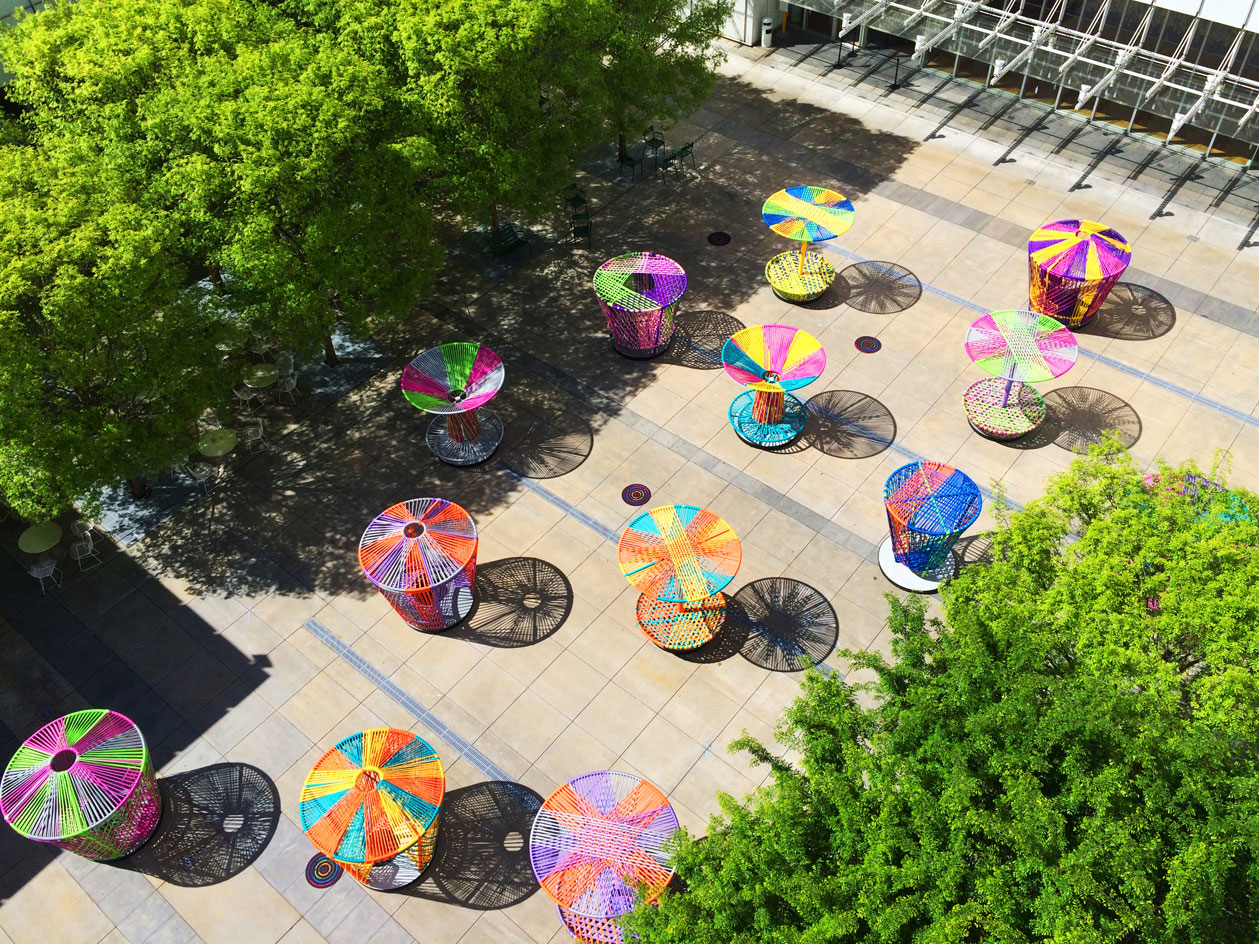
Los Trompos, High Museum of Art, Atlanta, US
Los Trompos is the Spanish translation of 'the spinning tops' – a traditional table top game which designers Esrawe + Cadena have enlarged for the playground as a whimsical and interactive installation on show across the piazza of Atlanta's High Museum of Art.
Writer: Sujata Burman.
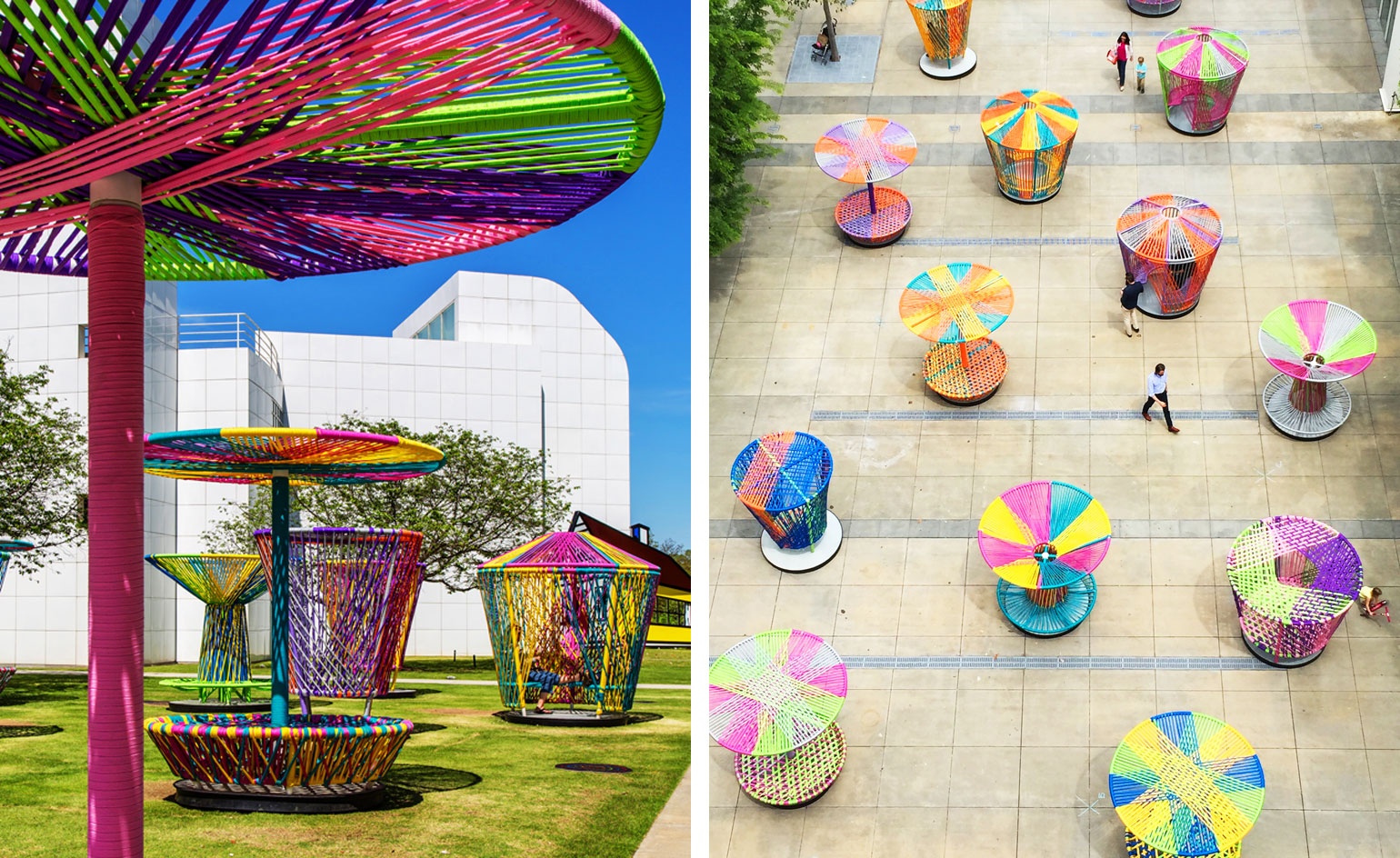
Los Trompos, High Museum of Art, Atlanta, US
The Mexican designers have woven together the installation's fabrics using artisan styles specific to their native culture. These intertwining techniques have created different pop-coloured patterns across circular structures, brightening up the usually all-white museum.
Writer: Sujata Burman
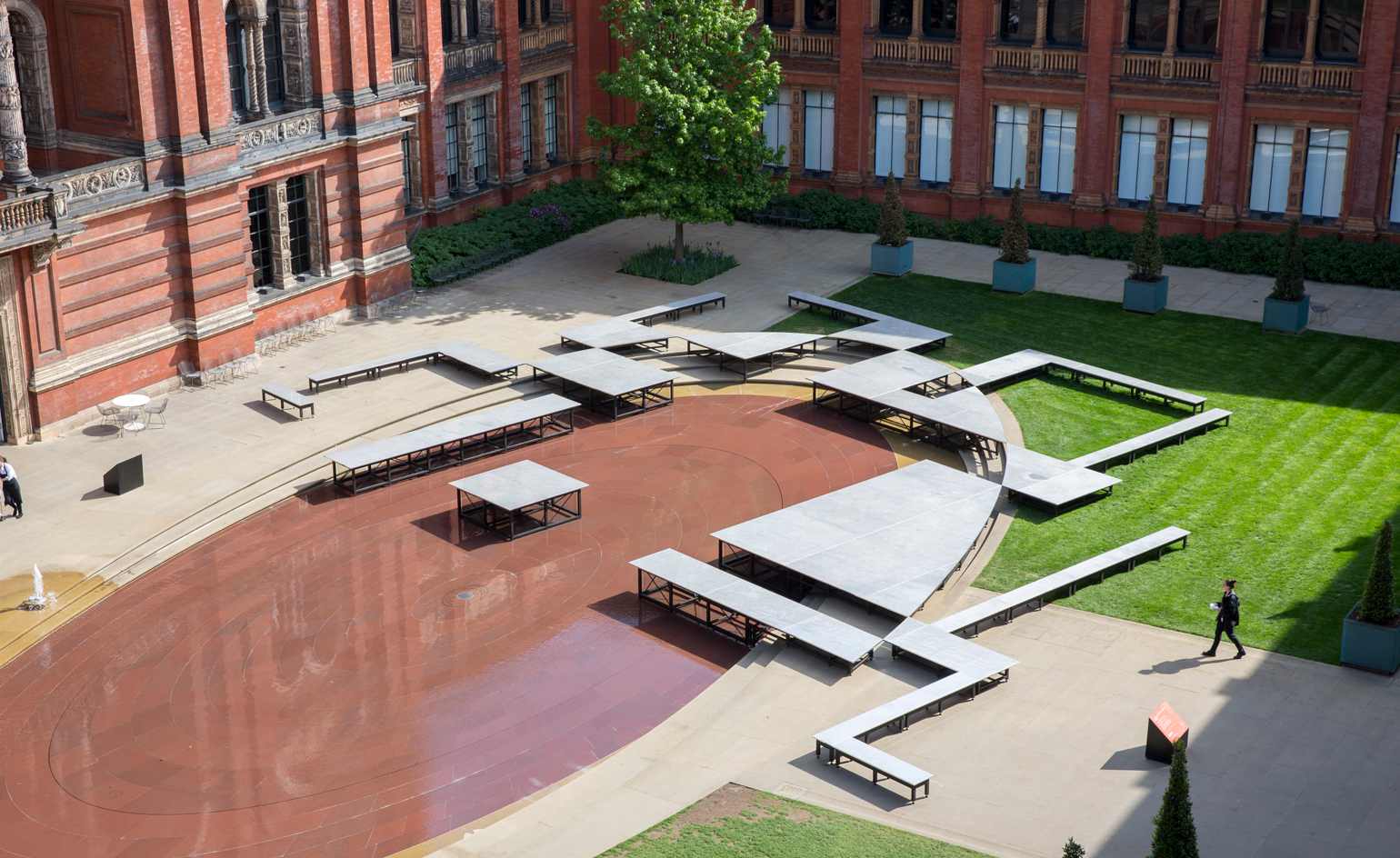
You Know You Cannot See Yourself So Well as by Reflection, V&A, UK
Paying homage to 'The Year of Mexico in the UK', the V&A's central courtyard is hosting Frida Escobedo's adaptable mirrored platforms. Having taken up residence in the John Madejski Garden in late May, the installation references the ancient Aztec city of Tenochtitlán, first discovered by Hernán Cortés and his troop of conquistadors.
Writer: Sam Rogers.
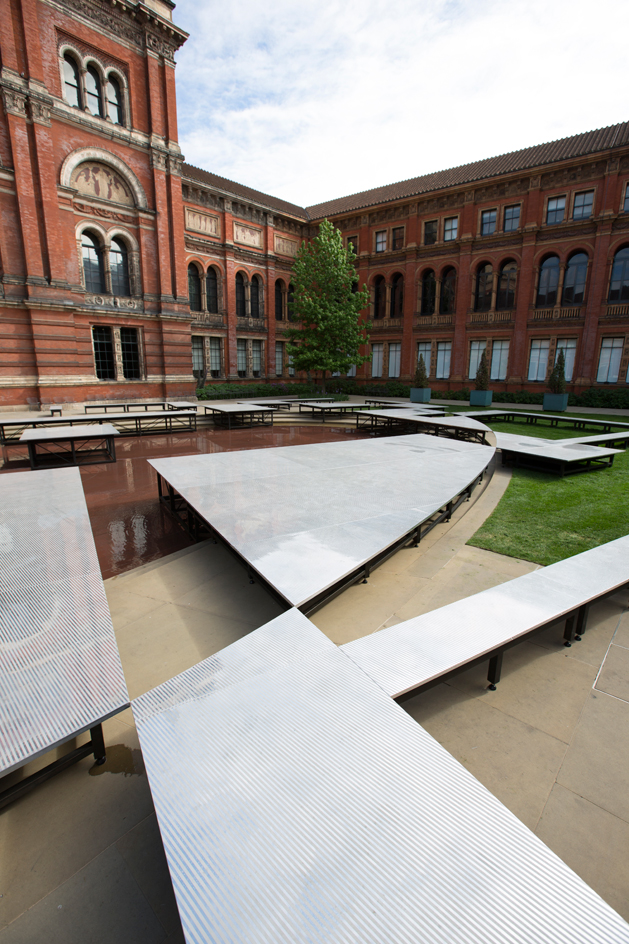
You Know You Cannot See Yourself So Well as by Reflection, V&A, UK
The flexible stages – made of curved and rectangular steel framed structures – can be reconfigured for different activities and are meant to reference the floating city that the Spaniards called 'the Venice of the New World'.
Writer: Sam Rogers.
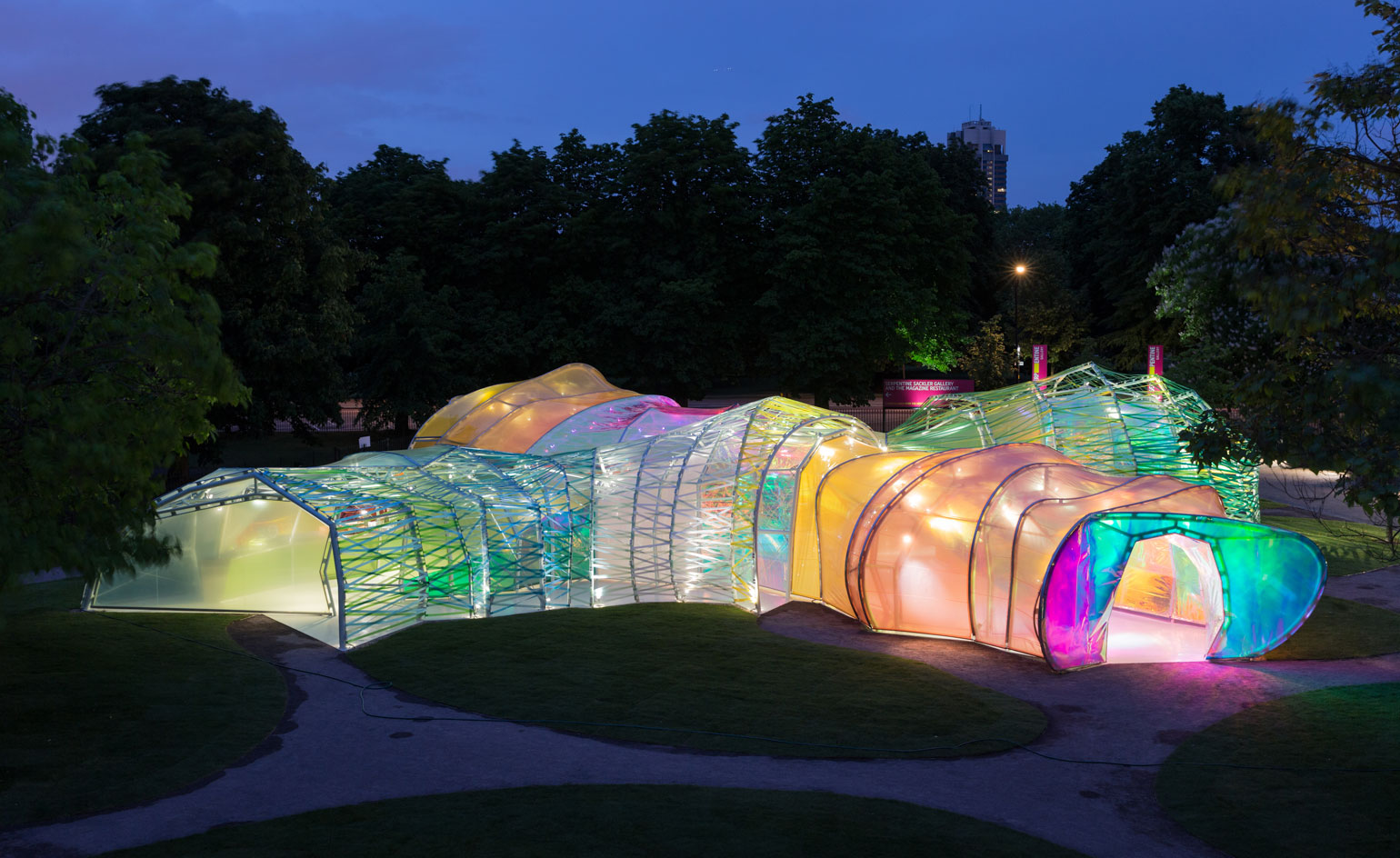
Serpentine Pavilion, Serpentine Gallery, UK
Typically marking the start of the British high summer season is the annual unveiling of the Serpentine Gallery's Pavillion commission, designed this year by the Spanish architecture practice SelgasCano. The low structure's amorphous shape is like nothing the park has seen before; eye-catching and photogenic, it brings to mind a sprawling, colourful caterpillar, or the retro-sci-fi set of an old episode of Doctor Who.
Writer: Ellie Stathiki.
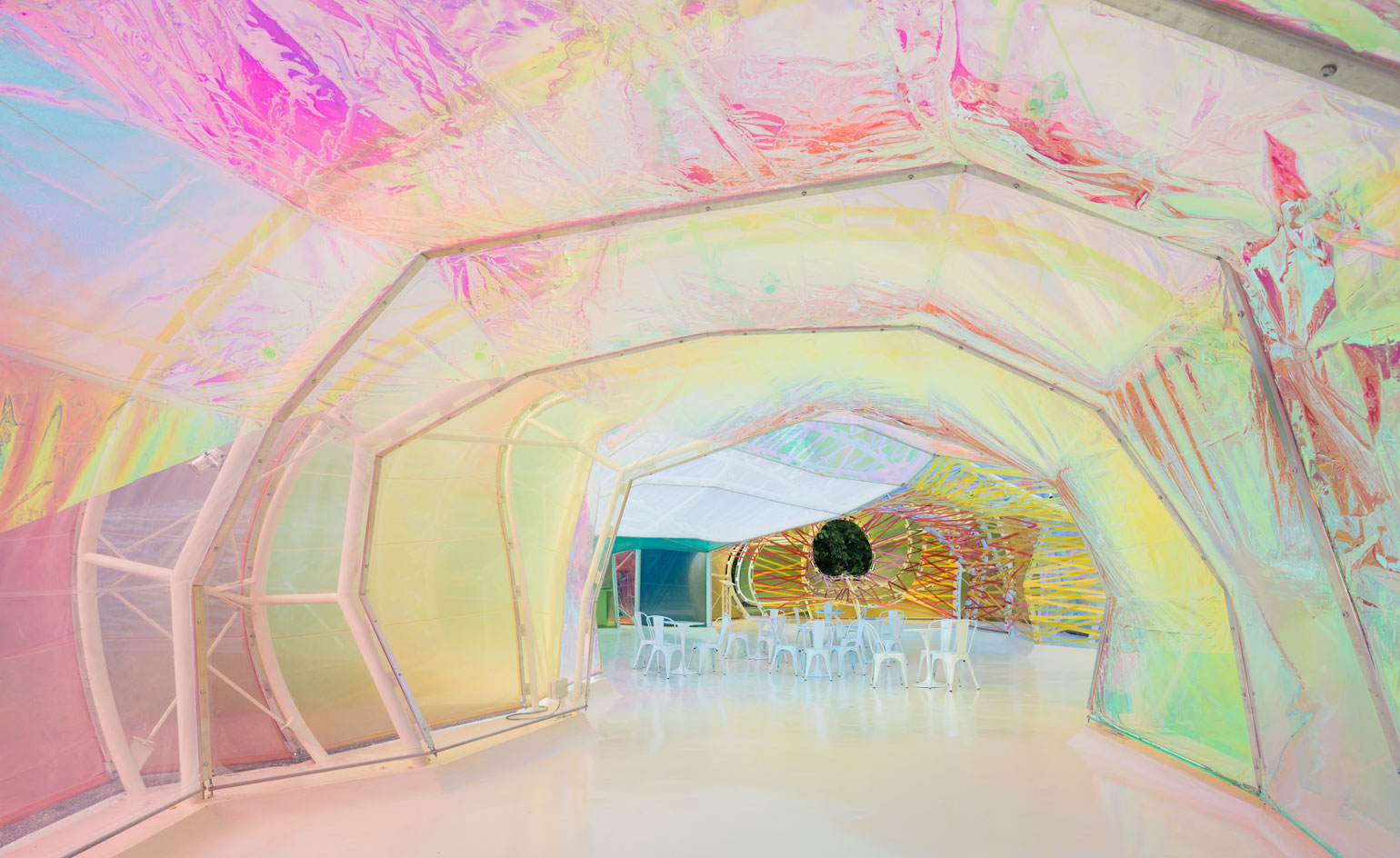
Serpentine Pavilion, Serpentine Gallery, UK
The Pavilion is constructed from panels of translucent, multi-coloured fluorine-based polymer (ETFE) which is woven and wrapped like webbing. A cafe sits at the centre, offering ice creams and refreshments courtesy of Fortnum & Mason to enjoy while you explore the structure's nucleus.
Writer: Ellie Stathiki.
-
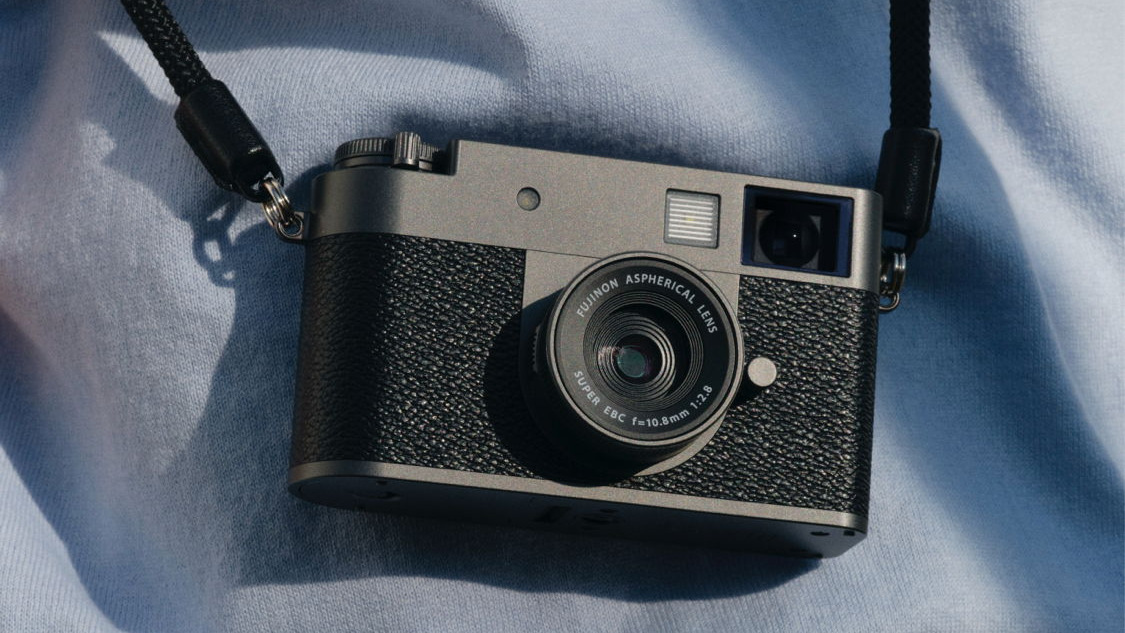 Five of the finest compact cameras available today
Five of the finest compact cameras available todayPocketable cameras are having a moment. We’ve assembled a set of cutting-edge compacts that’ll free you from the ubiquity of smartphone photography and help focus your image making
-
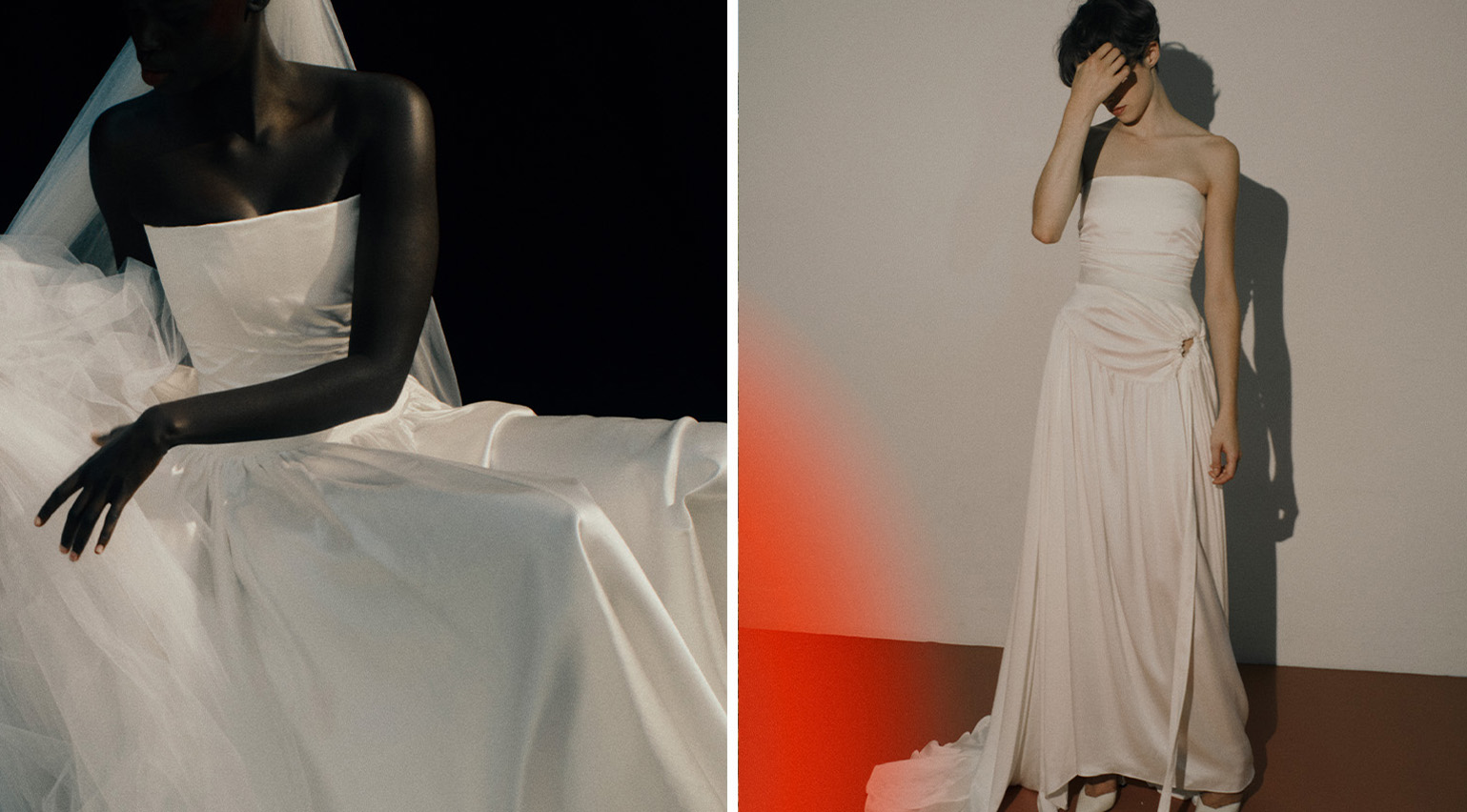 London label Wed Studio is embracing ‘oddness’ when it comes to bridal dressing
London label Wed Studio is embracing ‘oddness’ when it comes to bridal dressingThe in-the-know choice for fashion-discerning brides, Wed Studio’s latest collection explores the idea that garments can hold emotions – a reflection of designers Amy Trinh and Evan Phillips’ increasingly experimental approach
-
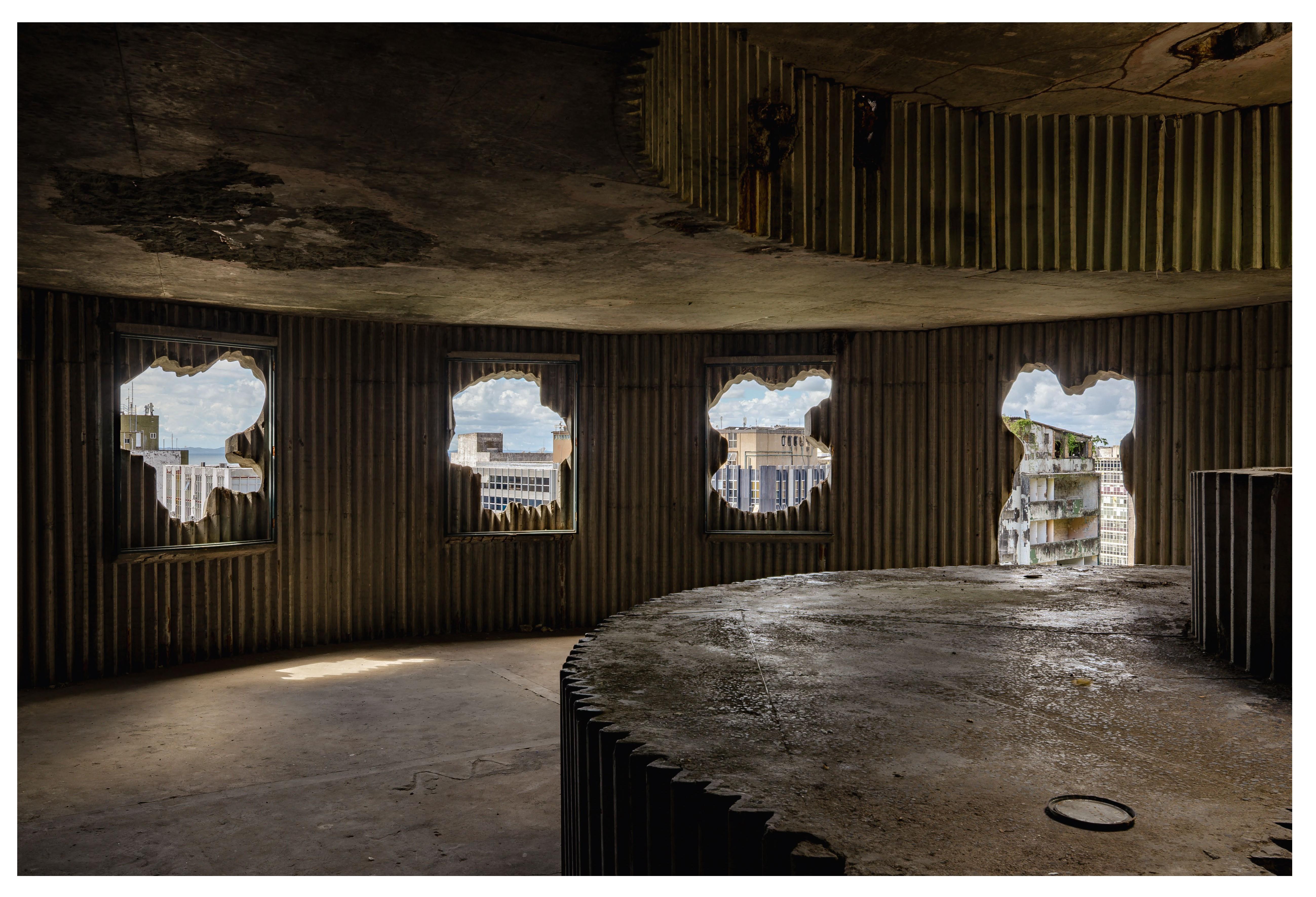 Arts institution Pivô breathes new life into neglected Lina Bo Bardi building in Bahia
Arts institution Pivô breathes new life into neglected Lina Bo Bardi building in BahiaNon-profit cultural institution Pivô is reactivating a Lina Bo Bardi landmark in Salvador da Bahia in a bid to foster artistic dialogue and community engagement